

Chapter 11. Interviewing
Introduction.
Interviewing people is at the heart of qualitative research. It is not merely a way to collect data but an intrinsically rewarding activity—an interaction between two people that holds the potential for greater understanding and interpersonal development. Unlike many of our daily interactions with others that are fairly shallow and mundane, sitting down with a person for an hour or two and really listening to what they have to say is a profound and deep enterprise, one that can provide not only “data” for you, the interviewer, but also self-understanding and a feeling of being heard for the interviewee. I always approach interviewing with a deep appreciation for the opportunity it gives me to understand how other people experience the world. That said, there is not one kind of interview but many, and some of these are shallower than others. This chapter will provide you with an overview of interview techniques but with a special focus on the in-depth semistructured interview guide approach, which is the approach most widely used in social science research.
An interview can be variously defined as “a conversation with a purpose” ( Lune and Berg 2018 ) and an attempt to understand the world from the point of view of the person being interviewed: “to unfold the meaning of peoples’ experiences, to uncover their lived world prior to scientific explanations” ( Kvale 2007 ). It is a form of active listening in which the interviewer steers the conversation to subjects and topics of interest to their research but also manages to leave enough space for those interviewed to say surprising things. Achieving that balance is a tricky thing, which is why most practitioners believe interviewing is both an art and a science. In my experience as a teacher, there are some students who are “natural” interviewers (often they are introverts), but anyone can learn to conduct interviews, and everyone, even those of us who have been doing this for years, can improve their interviewing skills. This might be a good time to highlight the fact that the interview is a product between interviewer and interviewee and that this product is only as good as the rapport established between the two participants. Active listening is the key to establishing this necessary rapport.
Patton ( 2002 ) makes the argument that we use interviews because there are certain things that are not observable. In particular, “we cannot observe feelings, thoughts, and intentions. We cannot observe behaviors that took place at some previous point in time. We cannot observe situations that preclude the presence of an observer. We cannot observe how people have organized the world and the meanings they attach to what goes on in the world. We have to ask people questions about those things” ( 341 ).
Types of Interviews
There are several distinct types of interviews. Imagine a continuum (figure 11.1). On one side are unstructured conversations—the kind you have with your friends. No one is in control of those conversations, and what you talk about is often random—whatever pops into your head. There is no secret, underlying purpose to your talking—if anything, the purpose is to talk to and engage with each other, and the words you use and the things you talk about are a little beside the point. An unstructured interview is a little like this informal conversation, except that one of the parties to the conversation (you, the researcher) does have an underlying purpose, and that is to understand the other person. You are not friends speaking for no purpose, but it might feel just as unstructured to the “interviewee” in this scenario. That is one side of the continuum. On the other side are fully structured and standardized survey-type questions asked face-to-face. Here it is very clear who is asking the questions and who is answering them. This doesn’t feel like a conversation at all! A lot of people new to interviewing have this ( erroneously !) in mind when they think about interviews as data collection. Somewhere in the middle of these two extreme cases is the “ semistructured” interview , in which the researcher uses an “interview guide” to gently move the conversation to certain topics and issues. This is the primary form of interviewing for qualitative social scientists and will be what I refer to as interviewing for the rest of this chapter, unless otherwise specified.

Informal (unstructured conversations). This is the most “open-ended” approach to interviewing. It is particularly useful in conjunction with observational methods (see chapters 13 and 14). There are no predetermined questions. Each interview will be different. Imagine you are researching the Oregon Country Fair, an annual event in Veneta, Oregon, that includes live music, artisan craft booths, face painting, and a lot of people walking through forest paths. It’s unlikely that you will be able to get a person to sit down with you and talk intensely about a set of questions for an hour and a half. But you might be able to sidle up to several people and engage with them about their experiences at the fair. You might have a general interest in what attracts people to these events, so you could start a conversation by asking strangers why they are here or why they come back every year. That’s it. Then you have a conversation that may lead you anywhere. Maybe one person tells a long story about how their parents brought them here when they were a kid. A second person talks about how this is better than Burning Man. A third person shares their favorite traveling band. And yet another enthuses about the public library in the woods. During your conversations, you also talk about a lot of other things—the weather, the utilikilts for sale, the fact that a favorite food booth has disappeared. It’s all good. You may not be able to record these conversations. Instead, you might jot down notes on the spot and then, when you have the time, write down as much as you can remember about the conversations in long fieldnotes. Later, you will have to sit down with these fieldnotes and try to make sense of all the information (see chapters 18 and 19).
Interview guide ( semistructured interview ). This is the primary type employed by social science qualitative researchers. The researcher creates an “interview guide” in advance, which she uses in every interview. In theory, every person interviewed is asked the same questions. In practice, every person interviewed is asked mostly the same topics but not always the same questions, as the whole point of a “guide” is that it guides the direction of the conversation but does not command it. The guide is typically between five and ten questions or question areas, sometimes with suggested follow-ups or prompts . For example, one question might be “What was it like growing up in Eastern Oregon?” with prompts such as “Did you live in a rural area? What kind of high school did you attend?” to help the conversation develop. These interviews generally take place in a quiet place (not a busy walkway during a festival) and are recorded. The recordings are transcribed, and those transcriptions then become the “data” that is analyzed (see chapters 18 and 19). The conventional length of one of these types of interviews is between one hour and two hours, optimally ninety minutes. Less than one hour doesn’t allow for much development of questions and thoughts, and two hours (or more) is a lot of time to ask someone to sit still and answer questions. If you have a lot of ground to cover, and the person is willing, I highly recommend two separate interview sessions, with the second session being slightly shorter than the first (e.g., ninety minutes the first day, sixty minutes the second). There are lots of good reasons for this, but the most compelling one is that this allows you to listen to the first day’s recording and catch anything interesting you might have missed in the moment and so develop follow-up questions that can probe further. This also allows the person being interviewed to have some time to think about the issues raised in the interview and go a little deeper with their answers.
Standardized questionnaire with open responses ( structured interview ). This is the type of interview a lot of people have in mind when they hear “interview”: a researcher comes to your door with a clipboard and proceeds to ask you a series of questions. These questions are all the same whoever answers the door; they are “standardized.” Both the wording and the exact order are important, as people’s responses may vary depending on how and when a question is asked. These are qualitative only in that the questions allow for “open-ended responses”: people can say whatever they want rather than select from a predetermined menu of responses. For example, a survey I collaborated on included this open-ended response question: “How does class affect one’s career success in sociology?” Some of the answers were simply one word long (e.g., “debt”), and others were long statements with stories and personal anecdotes. It is possible to be surprised by the responses. Although it’s a stretch to call this kind of questioning a conversation, it does allow the person answering the question some degree of freedom in how they answer.
Survey questionnaire with closed responses (not an interview!). Standardized survey questions with specific answer options (e.g., closed responses) are not really interviews at all, and they do not generate qualitative data. For example, if we included five options for the question “How does class affect one’s career success in sociology?”—(1) debt, (2) social networks, (3) alienation, (4) family doesn’t understand, (5) type of grad program—we leave no room for surprises at all. Instead, we would most likely look at patterns around these responses, thinking quantitatively rather than qualitatively (e.g., using regression analysis techniques, we might find that working-class sociologists were twice as likely to bring up alienation). It can sometimes be confusing for new students because the very same survey can include both closed-ended and open-ended questions. The key is to think about how these will be analyzed and to what level surprises are possible. If your plan is to turn all responses into a number and make predictions about correlations and relationships, you are no longer conducting qualitative research. This is true even if you are conducting this survey face-to-face with a real live human. Closed-response questions are not conversations of any kind, purposeful or not.
In summary, the semistructured interview guide approach is the predominant form of interviewing for social science qualitative researchers because it allows a high degree of freedom of responses from those interviewed (thus allowing for novel discoveries) while still maintaining some connection to a research question area or topic of interest. The rest of the chapter assumes the employment of this form.
Creating an Interview Guide
Your interview guide is the instrument used to bridge your research question(s) and what the people you are interviewing want to tell you. Unlike a standardized questionnaire, the questions actually asked do not need to be exactly what you have written down in your guide. The guide is meant to create space for those you are interviewing to talk about the phenomenon of interest, but sometimes you are not even sure what that phenomenon is until you start asking questions. A priority in creating an interview guide is to ensure it offers space. One of the worst mistakes is to create questions that are so specific that the person answering them will not stray. Relatedly, questions that sound “academic” will shut down a lot of respondents. A good interview guide invites respondents to talk about what is important to them, not feel like they are performing or being evaluated by you.
Good interview questions should not sound like your “research question” at all. For example, let’s say your research question is “How do patriarchal assumptions influence men’s understanding of climate change and responses to climate change?” It would be worse than unhelpful to ask a respondent, “How do your assumptions about the role of men affect your understanding of climate change?” You need to unpack this into manageable nuggets that pull your respondent into the area of interest without leading him anywhere. You could start by asking him what he thinks about climate change in general. Or, even better, whether he has any concerns about heatwaves or increased tornadoes or polar icecaps melting. Once he starts talking about that, you can ask follow-up questions that bring in issues around gendered roles, perhaps asking if he is married (to a woman) and whether his wife shares his thoughts and, if not, how they negotiate that difference. The fact is, you won’t really know the right questions to ask until he starts talking.
There are several distinct types of questions that can be used in your interview guide, either as main questions or as follow-up probes. If you remember that the point is to leave space for the respondent, you will craft a much more effective interview guide! You will also want to think about the place of time in both the questions themselves (past, present, future orientations) and the sequencing of the questions.
Researcher Note
Suggestion : As you read the next three sections (types of questions, temporality, question sequence), have in mind a particular research question, and try to draft questions and sequence them in a way that opens space for a discussion that helps you answer your research question.
Type of Questions
Experience and behavior questions ask about what a respondent does regularly (their behavior) or has done (their experience). These are relatively easy questions for people to answer because they appear more “factual” and less subjective. This makes them good opening questions. For the study on climate change above, you might ask, “Have you ever experienced an unusual weather event? What happened?” Or “You said you work outside? What is a typical summer workday like for you? How do you protect yourself from the heat?”
Opinion and values questions , in contrast, ask questions that get inside the minds of those you are interviewing. “Do you think climate change is real? Who or what is responsible for it?” are two such questions. Note that you don’t have to literally ask, “What is your opinion of X?” but you can find a way to ask the specific question relevant to the conversation you are having. These questions are a bit trickier to ask because the answers you get may depend in part on how your respondent perceives you and whether they want to please you or not. We’ve talked a fair amount about being reflective. Here is another place where this comes into play. You need to be aware of the effect your presence might have on the answers you are receiving and adjust accordingly. If you are a woman who is perceived as liberal asking a man who identifies as conservative about climate change, there is a lot of subtext that can be going on in the interview. There is no one right way to resolve this, but you must at least be aware of it.
Feeling questions are questions that ask respondents to draw on their emotional responses. It’s pretty common for academic researchers to forget that we have bodies and emotions, but people’s understandings of the world often operate at this affective level, sometimes unconsciously or barely consciously. It is a good idea to include questions that leave space for respondents to remember, imagine, or relive emotional responses to particular phenomena. “What was it like when you heard your cousin’s house burned down in that wildfire?” doesn’t explicitly use any emotion words, but it allows your respondent to remember what was probably a pretty emotional day. And if they respond emotionally neutral, that is pretty interesting data too. Note that asking someone “How do you feel about X” is not always going to evoke an emotional response, as they might simply turn around and respond with “I think that…” It is better to craft a question that actually pushes the respondent into the affective category. This might be a specific follow-up to an experience and behavior question —for example, “You just told me about your daily routine during the summer heat. Do you worry it is going to get worse?” or “Have you ever been afraid it will be too hot to get your work accomplished?”
Knowledge questions ask respondents what they actually know about something factual. We have to be careful when we ask these types of questions so that respondents do not feel like we are evaluating them (which would shut them down), but, for example, it is helpful to know when you are having a conversation about climate change that your respondent does in fact know that unusual weather events have increased and that these have been attributed to climate change! Asking these questions can set the stage for deeper questions and can ensure that the conversation makes the same kind of sense to both participants. For example, a conversation about political polarization can be put back on track once you realize that the respondent doesn’t really have a clear understanding that there are two parties in the US. Instead of asking a series of questions about Republicans and Democrats, you might shift your questions to talk more generally about political disagreements (e.g., “people against abortion”). And sometimes what you do want to know is the level of knowledge about a particular program or event (e.g., “Are you aware you can discharge your student loans through the Public Service Loan Forgiveness program?”).
Sensory questions call on all senses of the respondent to capture deeper responses. These are particularly helpful in sparking memory. “Think back to your childhood in Eastern Oregon. Describe the smells, the sounds…” Or you could use these questions to help a person access the full experience of a setting they customarily inhabit: “When you walk through the doors to your office building, what do you see? Hear? Smell?” As with feeling questions , these questions often supplement experience and behavior questions . They are another way of allowing your respondent to report fully and deeply rather than remain on the surface.
Creative questions employ illustrative examples, suggested scenarios, or simulations to get respondents to think more deeply about an issue, topic, or experience. There are many options here. In The Trouble with Passion , Erin Cech ( 2021 ) provides a scenario in which “Joe” is trying to decide whether to stay at his decent but boring computer job or follow his passion by opening a restaurant. She asks respondents, “What should Joe do?” Their answers illuminate the attraction of “passion” in job selection. In my own work, I have used a news story about an upwardly mobile young man who no longer has time to see his mother and sisters to probe respondents’ feelings about the costs of social mobility. Jessi Streib and Betsy Leondar-Wright have used single-page cartoon “scenes” to elicit evaluations of potential racial discrimination, sexual harassment, and classism. Barbara Sutton ( 2010 ) has employed lists of words (“strong,” “mother,” “victim”) on notecards she fans out and asks her female respondents to select and discuss.
Background/Demographic Questions
You most definitely will want to know more about the person you are interviewing in terms of conventional demographic information, such as age, race, gender identity, occupation, and educational attainment. These are not questions that normally open up inquiry. [1] For this reason, my practice has been to include a separate “demographic questionnaire” sheet that I ask each respondent to fill out at the conclusion of the interview. Only include those aspects that are relevant to your study. For example, if you are not exploring religion or religious affiliation, do not include questions about a person’s religion on the demographic sheet. See the example provided at the end of this chapter.
Temporality
Any type of question can have a past, present, or future orientation. For example, if you are asking a behavior question about workplace routine, you might ask the respondent to talk about past work, present work, and ideal (future) work. Similarly, if you want to understand how people cope with natural disasters, you might ask your respondent how they felt then during the wildfire and now in retrospect and whether and to what extent they have concerns for future wildfire disasters. It’s a relatively simple suggestion—don’t forget to ask about past, present, and future—but it can have a big impact on the quality of the responses you receive.
Question Sequence
Having a list of good questions or good question areas is not enough to make a good interview guide. You will want to pay attention to the order in which you ask your questions. Even though any one respondent can derail this order (perhaps by jumping to answer a question you haven’t yet asked), a good advance plan is always helpful. When thinking about sequence, remember that your goal is to get your respondent to open up to you and to say things that might surprise you. To establish rapport, it is best to start with nonthreatening questions. Asking about the present is often the safest place to begin, followed by the past (they have to know you a little bit to get there), and lastly, the future (talking about hopes and fears requires the most rapport). To allow for surprises, it is best to move from very general questions to more particular questions only later in the interview. This ensures that respondents have the freedom to bring up the topics that are relevant to them rather than feel like they are constrained to answer you narrowly. For example, refrain from asking about particular emotions until these have come up previously—don’t lead with them. Often, your more particular questions will emerge only during the course of the interview, tailored to what is emerging in conversation.
Once you have a set of questions, read through them aloud and imagine you are being asked the same questions. Does the set of questions have a natural flow? Would you be willing to answer the very first question to a total stranger? Does your sequence establish facts and experiences before moving on to opinions and values? Did you include prefatory statements, where necessary; transitions; and other announcements? These can be as simple as “Hey, we talked a lot about your experiences as a barista while in college.… Now I am turning to something completely different: how you managed friendships in college.” That is an abrupt transition, but it has been softened by your acknowledgment of that.
Probes and Flexibility
Once you have the interview guide, you will also want to leave room for probes and follow-up questions. As in the sample probe included here, you can write out the obvious probes and follow-up questions in advance. You might not need them, as your respondent might anticipate them and include full responses to the original question. Or you might need to tailor them to how your respondent answered the question. Some common probes and follow-up questions include asking for more details (When did that happen? Who else was there?), asking for elaboration (Could you say more about that?), asking for clarification (Does that mean what I think it means or something else? I understand what you mean, but someone else reading the transcript might not), and asking for contrast or comparison (How did this experience compare with last year’s event?). “Probing is a skill that comes from knowing what to look for in the interview, listening carefully to what is being said and what is not said, and being sensitive to the feedback needs of the person being interviewed” ( Patton 2002:374 ). It takes work! And energy. I and many other interviewers I know report feeling emotionally and even physically drained after conducting an interview. You are tasked with active listening and rearranging your interview guide as needed on the fly. If you only ask the questions written down in your interview guide with no deviations, you are doing it wrong. [2]
The Final Question
Every interview guide should include a very open-ended final question that allows for the respondent to say whatever it is they have been dying to tell you but you’ve forgotten to ask. About half the time they are tired too and will tell you they have nothing else to say. But incredibly, some of the most honest and complete responses take place here, at the end of a long interview. You have to realize that the person being interviewed is often discovering things about themselves as they talk to you and that this process of discovery can lead to new insights for them. Making space at the end is therefore crucial. Be sure you convey that you actually do want them to tell you more, that the offer of “anything else?” is not read as an empty convention where the polite response is no. Here is where you can pull from that active listening and tailor the final question to the particular person. For example, “I’ve asked you a lot of questions about what it was like to live through that wildfire. I’m wondering if there is anything I’ve forgotten to ask, especially because I haven’t had that experience myself” is a much more inviting final question than “Great. Anything you want to add?” It’s also helpful to convey to the person that you have the time to listen to their full answer, even if the allotted time is at the end. After all, there are no more questions to ask, so the respondent knows exactly how much time is left. Do them the courtesy of listening to them!
Conducting the Interview
Once you have your interview guide, you are on your way to conducting your first interview. I always practice my interview guide with a friend or family member. I do this even when the questions don’t make perfect sense for them, as it still helps me realize which questions make no sense, are poorly worded (too academic), or don’t follow sequentially. I also practice the routine I will use for interviewing, which goes something like this:
- Introduce myself and reintroduce the study
- Provide consent form and ask them to sign and retain/return copy
- Ask if they have any questions about the study before we begin
- Ask if I can begin recording
- Ask questions (from interview guide)
- Turn off the recording device
- Ask if they are willing to fill out my demographic questionnaire
- Collect questionnaire and, without looking at the answers, place in same folder as signed consent form
- Thank them and depart
A note on remote interviewing: Interviews have traditionally been conducted face-to-face in a private or quiet public setting. You don’t want a lot of background noise, as this will make transcriptions difficult. During the recent global pandemic, many interviewers, myself included, learned the benefits of interviewing remotely. Although face-to-face is still preferable for many reasons, Zoom interviewing is not a bad alternative, and it does allow more interviews across great distances. Zoom also includes automatic transcription, which significantly cuts down on the time it normally takes to convert our conversations into “data” to be analyzed. These automatic transcriptions are not perfect, however, and you will still need to listen to the recording and clarify and clean up the transcription. Nor do automatic transcriptions include notations of body language or change of tone, which you may want to include. When interviewing remotely, you will want to collect the consent form before you meet: ask them to read, sign, and return it as an email attachment. I think it is better to ask for the demographic questionnaire after the interview, but because some respondents may never return it then, it is probably best to ask for this at the same time as the consent form, in advance of the interview.
What should you bring to the interview? I would recommend bringing two copies of the consent form (one for you and one for the respondent), a demographic questionnaire, a manila folder in which to place the signed consent form and filled-out demographic questionnaire, a printed copy of your interview guide (I print with three-inch right margins so I can jot down notes on the page next to relevant questions), a pen, a recording device, and water.
After the interview, you will want to secure the signed consent form in a locked filing cabinet (if in print) or a password-protected folder on your computer. Using Excel or a similar program that allows tables/spreadsheets, create an identifying number for your interview that links to the consent form without using the name of your respondent. For example, let’s say that I conduct interviews with US politicians, and the first person I meet with is George W. Bush. I will assign the transcription the number “INT#001” and add it to the signed consent form. [3] The signed consent form goes into a locked filing cabinet, and I never use the name “George W. Bush” again. I take the information from the demographic sheet, open my Excel spreadsheet, and add the relevant information in separate columns for the row INT#001: White, male, Republican. When I interview Bill Clinton as my second interview, I include a second row: INT#002: White, male, Democrat. And so on. The only link to the actual name of the respondent and this information is the fact that the consent form (unavailable to anyone but me) has stamped on it the interview number.
Many students get very nervous before their first interview. Actually, many of us are always nervous before the interview! But do not worry—this is normal, and it does pass. Chances are, you will be pleasantly surprised at how comfortable it begins to feel. These “purposeful conversations” are often a delight for both participants. This is not to say that sometimes things go wrong. I often have my students practice several “bad scenarios” (e.g., a respondent that you cannot get to open up; a respondent who is too talkative and dominates the conversation, steering it away from the topics you are interested in; emotions that completely take over; or shocking disclosures you are ill-prepared to handle), but most of the time, things go quite well. Be prepared for the unexpected, but know that the reason interviews are so popular as a technique of data collection is that they are usually richly rewarding for both participants.
One thing that I stress to my methods students and remind myself about is that interviews are still conversations between people. If there’s something you might feel uncomfortable asking someone about in a “normal” conversation, you will likely also feel a bit of discomfort asking it in an interview. Maybe more importantly, your respondent may feel uncomfortable. Social research—especially about inequality—can be uncomfortable. And it’s easy to slip into an abstract, intellectualized, or removed perspective as an interviewer. This is one reason trying out interview questions is important. Another is that sometimes the question sounds good in your head but doesn’t work as well out loud in practice. I learned this the hard way when a respondent asked me how I would answer the question I had just posed, and I realized that not only did I not really know how I would answer it, but I also wasn’t quite as sure I knew what I was asking as I had thought.
—Elizabeth M. Lee, Associate Professor of Sociology at Saint Joseph’s University, author of Class and Campus Life , and co-author of Geographies of Campus Inequality
How Many Interviews?
Your research design has included a targeted number of interviews and a recruitment plan (see chapter 5). Follow your plan, but remember that “ saturation ” is your goal. You interview as many people as you can until you reach a point at which you are no longer surprised by what they tell you. This means not that no one after your first twenty interviews will have surprising, interesting stories to tell you but rather that the picture you are forming about the phenomenon of interest to you from a research perspective has come into focus, and none of the interviews are substantially refocusing that picture. That is when you should stop collecting interviews. Note that to know when you have reached this, you will need to read your transcripts as you go. More about this in chapters 18 and 19.
Your Final Product: The Ideal Interview Transcript
A good interview transcript will demonstrate a subtly controlled conversation by the skillful interviewer. In general, you want to see replies that are about one paragraph long, not short sentences and not running on for several pages. Although it is sometimes necessary to follow respondents down tangents, it is also often necessary to pull them back to the questions that form the basis of your research study. This is not really a free conversation, although it may feel like that to the person you are interviewing.
Final Tips from an Interview Master
Annette Lareau is arguably one of the masters of the trade. In Listening to People , she provides several guidelines for good interviews and then offers a detailed example of an interview gone wrong and how it could be addressed (please see the “Further Readings” at the end of this chapter). Here is an abbreviated version of her set of guidelines: (1) interview respondents who are experts on the subjects of most interest to you (as a corollary, don’t ask people about things they don’t know); (2) listen carefully and talk as little as possible; (3) keep in mind what you want to know and why you want to know it; (4) be a proactive interviewer (subtly guide the conversation); (5) assure respondents that there aren’t any right or wrong answers; (6) use the respondent’s own words to probe further (this both allows you to accurately identify what you heard and pushes the respondent to explain further); (7) reuse effective probes (don’t reinvent the wheel as you go—if repeating the words back works, do it again and again); (8) focus on learning the subjective meanings that events or experiences have for a respondent; (9) don’t be afraid to ask a question that draws on your own knowledge (unlike trial lawyers who are trained never to ask a question for which they don’t already know the answer, sometimes it’s worth it to ask risky questions based on your hypotheses or just plain hunches); (10) keep thinking while you are listening (so difficult…and important); (11) return to a theme raised by a respondent if you want further information; (12) be mindful of power inequalities (and never ever coerce a respondent to continue the interview if they want out); (13) take control with overly talkative respondents; (14) expect overly succinct responses, and develop strategies for probing further; (15) balance digging deep and moving on; (16) develop a plan to deflect questions (e.g., let them know you are happy to answer any questions at the end of the interview, but you don’t want to take time away from them now); and at the end, (17) check to see whether you have asked all your questions. You don’t always have to ask everyone the same set of questions, but if there is a big area you have forgotten to cover, now is the time to recover ( Lareau 2021:93–103 ).
Sample: Demographic Questionnaire
ASA Taskforce on First-Generation and Working-Class Persons in Sociology – Class Effects on Career Success
Supplementary Demographic Questionnaire
Thank you for your participation in this interview project. We would like to collect a few pieces of key demographic information from you to supplement our analyses. Your answers to these questions will be kept confidential and stored by ID number. All of your responses here are entirely voluntary!
What best captures your race/ethnicity? (please check any/all that apply)
- White (Non Hispanic/Latina/o/x)
- Black or African American
- Hispanic, Latino/a/x of Spanish
- Asian or Asian American
- American Indian or Alaska Native
- Middle Eastern or North African
- Native Hawaiian or Pacific Islander
- Other : (Please write in: ________________)
What is your current position?
- Grad Student
- Full Professor
Please check any and all of the following that apply to you:
- I identify as a working-class academic
- I was the first in my family to graduate from college
- I grew up poor
What best reflects your gender?
- Transgender female/Transgender woman
- Transgender male/Transgender man
- Gender queer/ Gender nonconforming
Anything else you would like us to know about you?
Example: Interview Guide
In this example, follow-up prompts are italicized. Note the sequence of questions. That second question often elicits an entire life history , answering several later questions in advance.
Introduction Script/Question
Thank you for participating in our survey of ASA members who identify as first-generation or working-class. As you may have heard, ASA has sponsored a taskforce on first-generation and working-class persons in sociology and we are interested in hearing from those who so identify. Your participation in this interview will help advance our knowledge in this area.
- The first thing we would like to as you is why you have volunteered to be part of this study? What does it mean to you be first-gen or working class? Why were you willing to be interviewed?
- How did you decide to become a sociologist?
- Can you tell me a little bit about where you grew up? ( prompts: what did your parent(s) do for a living? What kind of high school did you attend?)
- Has this identity been salient to your experience? (how? How much?)
- How welcoming was your grad program? Your first academic employer?
- Why did you decide to pursue sociology at the graduate level?
- Did you experience culture shock in college? In graduate school?
- Has your FGWC status shaped how you’ve thought about where you went to school? debt? etc?
- Were you mentored? How did this work (not work)? How might it?
- What did you consider when deciding where to go to grad school? Where to apply for your first position?
- What, to you, is a mark of career success? Have you achieved that success? What has helped or hindered your pursuit of success?
- Do you think sociology, as a field, cares about prestige?
- Let’s talk a little bit about intersectionality. How does being first-gen/working class work alongside other identities that are important to you?
- What do your friends and family think about your career? Have you had any difficulty relating to family members or past friends since becoming highly educated?
- Do you have any debt from college/grad school? Are you concerned about this? Could you explain more about how you paid for college/grad school? (here, include assistance from family, fellowships, scholarships, etc.)
- (You’ve mentioned issues or obstacles you had because of your background.) What could have helped? Or, who or what did? Can you think of fortuitous moments in your career?
- Do you have any regrets about the path you took?
- Is there anything else you would like to add? Anything that the Taskforce should take note of, that we did not ask you about here?
Further Readings
Britten, Nicky. 1995. “Qualitative Interviews in Medical Research.” BMJ: British Medical Journal 31(6999):251–253. A good basic overview of interviewing particularly useful for students of public health and medical research generally.
Corbin, Juliet, and Janice M. Morse. 2003. “The Unstructured Interactive Interview: Issues of Reciprocity and Risks When Dealing with Sensitive Topics.” Qualitative Inquiry 9(3):335–354. Weighs the potential benefits and harms of conducting interviews on topics that may cause emotional distress. Argues that the researcher’s skills and code of ethics should ensure that the interviewing process provides more of a benefit to both participant and researcher than a harm to the former.
Gerson, Kathleen, and Sarah Damaske. 2020. The Science and Art of Interviewing . New York: Oxford University Press. A useful guidebook/textbook for both undergraduates and graduate students, written by sociologists.
Kvale, Steiner. 2007. Doing Interviews . London: SAGE. An easy-to-follow guide to conducting and analyzing interviews by psychologists.
Lamont, Michèle, and Ann Swidler. 2014. “Methodological Pluralism and the Possibilities and Limits of Interviewing.” Qualitative Sociology 37(2):153–171. Written as a response to various debates surrounding the relative value of interview-based studies and ethnographic studies defending the particular strengths of interviewing. This is a must-read article for anyone seriously engaging in qualitative research!
Pugh, Allison J. 2013. “What Good Are Interviews for Thinking about Culture? Demystifying Interpretive Analysis.” American Journal of Cultural Sociology 1(1):42–68. Another defense of interviewing written against those who champion ethnographic methods as superior, particularly in the area of studying culture. A classic.
Rapley, Timothy John. 2001. “The ‘Artfulness’ of Open-Ended Interviewing: Some considerations in analyzing interviews.” Qualitative Research 1(3):303–323. Argues for the importance of “local context” of data production (the relationship built between interviewer and interviewee, for example) in properly analyzing interview data.
Weiss, Robert S. 1995. Learning from Strangers: The Art and Method of Qualitative Interview Studies . New York: Simon and Schuster. A classic and well-regarded textbook on interviewing. Because Weiss has extensive experience conducting surveys, he contrasts the qualitative interview with the survey questionnaire well; particularly useful for those trained in the latter.
- I say “normally” because how people understand their various identities can itself be an expansive topic of inquiry. Here, I am merely talking about collecting otherwise unexamined demographic data, similar to how we ask people to check boxes on surveys. ↵
- Again, this applies to “semistructured in-depth interviewing.” When conducting standardized questionnaires, you will want to ask each question exactly as written, without deviations! ↵
- I always include “INT” in the number because I sometimes have other kinds of data with their own numbering: FG#001 would mean the first focus group, for example. I also always include three-digit spaces, as this allows for up to 999 interviews (or, more realistically, allows for me to interview up to one hundred persons without having to reset my numbering system). ↵
A method of data collection in which the researcher asks the participant questions; the answers to these questions are often recorded and transcribed verbatim. There are many different kinds of interviews - see also semistructured interview , structured interview , and unstructured interview .
A document listing key questions and question areas for use during an interview. It is used most often for semi-structured interviews. A good interview guide may have no more than ten primary questions for two hours of interviewing, but these ten questions will be supplemented by probes and relevant follow-ups throughout the interview. Most IRBs require the inclusion of the interview guide in applications for review. See also interview and semi-structured interview .
A data-collection method that relies on casual, conversational, and informal interviewing. Despite its apparent conversational nature, the researcher usually has a set of particular questions or question areas in mind but allows the interview to unfold spontaneously. This is a common data-collection technique among ethnographers. Compare to the semi-structured or in-depth interview .
A form of interview that follows a standard guide of questions asked, although the order of the questions may change to match the particular needs of each individual interview subject, and probing “follow-up” questions are often added during the course of the interview. The semi-structured interview is the primary form of interviewing used by qualitative researchers in the social sciences. It is sometimes referred to as an “in-depth” interview. See also interview and interview guide .
The cluster of data-collection tools and techniques that involve observing interactions between people, the behaviors, and practices of individuals (sometimes in contrast to what they say about how they act and behave), and cultures in context. Observational methods are the key tools employed by ethnographers and Grounded Theory .
Follow-up questions used in a semi-structured interview to elicit further elaboration. Suggested prompts can be included in the interview guide to be used/deployed depending on how the initial question was answered or if the topic of the prompt does not emerge spontaneously.
A form of interview that follows a strict set of questions, asked in a particular order, for all interview subjects. The questions are also the kind that elicits short answers, and the data is more “informative” than probing. This is often used in mixed-methods studies, accompanying a survey instrument. Because there is no room for nuance or the exploration of meaning in structured interviews, qualitative researchers tend to employ semi-structured interviews instead. See also interview.
The point at which you can conclude data collection because every person you are interviewing, the interaction you are observing, or content you are analyzing merely confirms what you have already noted. Achieving saturation is often used as the justification for the final sample size.
An interview variant in which a person’s life story is elicited in a narrative form. Turning points and key themes are established by the researcher and used as data points for further analysis.
Introduction to Qualitative Research Methods Copyright © 2023 by Allison Hurst is licensed under a Creative Commons Attribution-ShareAlike 4.0 International License , except where otherwise noted.
Qualitative Data Coding 101
How to code qualitative data, the smart way (with examples).
By: Jenna Crosley (PhD) | Reviewed by:Dr Eunice Rautenbach | December 2020
As we’ve discussed previously , qualitative research makes use of non-numerical data – for example, words, phrases or even images and video. To analyse this kind of data, the first dragon you’ll need to slay is qualitative data coding (or just “coding” if you want to sound cool). But what exactly is coding and how do you do it?
Overview: Qualitative Data Coding
In this post, we’ll explain qualitative data coding in simple terms. Specifically, we’ll dig into:
- What exactly qualitative data coding is
- What different types of coding exist
- How to code qualitative data (the process)
- Moving from coding to qualitative analysis
- Tips and tricks for quality data coding
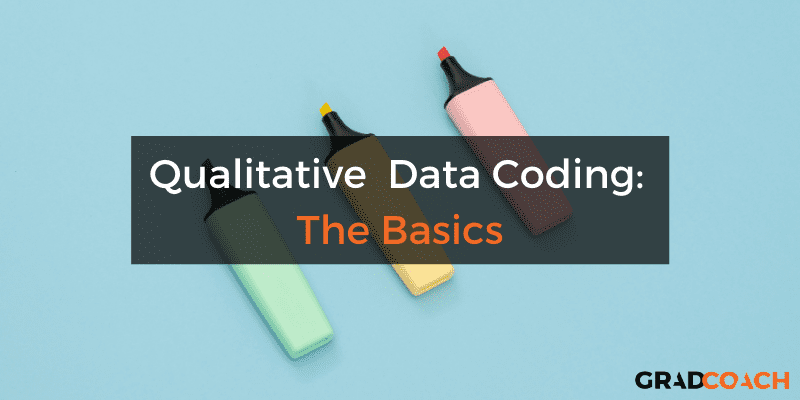
What is qualitative data coding?
Let’s start by understanding what a code is. At the simplest level, a code is a label that describes the content of a piece of text. For example, in the sentence:
“Pigeons attacked me and stole my sandwich.”
You could use “pigeons” as a code. This code simply describes that the sentence involves pigeons.
So, building onto this, qualitative data coding is the process of creating and assigning codes to categorise data extracts. You’ll then use these codes later down the road to derive themes and patterns for your qualitative analysis (for example, thematic analysis ). Coding and analysis can take place simultaneously, but it’s important to note that coding does not necessarily involve identifying themes (depending on which textbook you’re reading, of course). Instead, it generally refers to the process of labelling and grouping similar types of data to make generating themes and analysing the data more manageable.
Makes sense? Great. But why should you bother with coding at all? Why not just look for themes from the outset? Well, coding is a way of making sure your data is valid . In other words, it helps ensure that your analysis is undertaken systematically and that other researchers can review it (in the world of research, we call this transparency). In other words, good coding is the foundation of high-quality analysis.

What are the different types of coding?
Now that we’ve got a plain-language definition of coding on the table, the next step is to understand what overarching types of coding exist – in other words, coding approaches . Let’s start with the two main approaches, inductive and deductive .
With deductive coding, you, as the researcher, begin with a set of pre-established codes and apply them to your data set (for example, a set of interview transcripts). Inductive coding on the other hand, works in reverse, as you create the set of codes based on the data itself – in other words, the codes emerge from the data. Let’s take a closer look at both.
Deductive coding 101
With deductive coding, we make use of pre-established codes, which are developed before you interact with the present data. This usually involves drawing up a set of codes based on a research question or previous research . You could also use a code set from the codebook of a previous study.
For example, if you were studying the eating habits of college students, you might have a research question along the lines of
“What foods do college students eat the most?”
As a result of this research question, you might develop a code set that includes codes such as “sushi”, “pizza”, and “burgers”.
Deductive coding allows you to approach your analysis with a very tightly focused lens and quickly identify relevant data . Of course, the downside is that you could miss out on some very valuable insights as a result of this tight, predetermined focus.

Inductive coding 101
But what about inductive coding? As we touched on earlier, this type of coding involves jumping right into the data and then developing the codes based on what you find within the data.
For example, if you were to analyse a set of open-ended interviews , you wouldn’t necessarily know which direction the conversation would flow. If a conversation begins with a discussion of cats, it may go on to include other animals too, and so you’d add these codes as you progress with your analysis. Simply put, with inductive coding, you “go with the flow” of the data.
Inductive coding is great when you’re researching something that isn’t yet well understood because the coding derived from the data helps you explore the subject. Therefore, this type of coding is usually used when researchers want to investigate new ideas or concepts , or when they want to create new theories.

A little bit of both… hybrid coding approaches
If you’ve got a set of codes you’ve derived from a research topic, literature review or a previous study (i.e. a deductive approach), but you still don’t have a rich enough set to capture the depth of your qualitative data, you can combine deductive and inductive methods – this is called a hybrid coding approach.
To adopt a hybrid approach, you’ll begin your analysis with a set of a priori codes (deductive) and then add new codes (inductive) as you work your way through the data. Essentially, the hybrid coding approach provides the best of both worlds, which is why it’s pretty common to see this in research.
Need a helping hand?
How to code qualitative data
Now that we’ve looked at the main approaches to coding, the next question you’re probably asking is “how do I actually do it?”. Let’s take a look at the coding process , step by step.
Both inductive and deductive methods of coding typically occur in two stages: initial coding and line by line coding .
In the initial coding stage, the objective is to get a general overview of the data by reading through and understanding it. If you’re using an inductive approach, this is also where you’ll develop an initial set of codes. Then, in the second stage (line by line coding), you’ll delve deeper into the data and (re)organise it according to (potentially new) codes.
Step 1 – Initial coding
The first step of the coding process is to identify the essence of the text and code it accordingly. While there are various qualitative analysis software packages available, you can just as easily code textual data using Microsoft Word’s “comments” feature.
Let’s take a look at a practical example of coding. Assume you had the following interview data from two interviewees:
What pets do you have?
I have an alpaca and three dogs.
Only one alpaca? They can die of loneliness if they don’t have a friend.
I didn’t know that! I’ll just have to get five more.
I have twenty-three bunnies. I initially only had two, I’m not sure what happened.
In the initial stage of coding, you could assign the code of “pets” or “animals”. These are just initial, fairly broad codes that you can (and will) develop and refine later. In the initial stage, broad, rough codes are fine – they’re just a starting point which you will build onto in the second stage.

How to decide which codes to use
But how exactly do you decide what codes to use when there are many ways to read and interpret any given sentence? Well, there are a few different approaches you can adopt. The main approaches to initial coding include:
- In vivo coding
Process coding
- Open coding
Descriptive coding
Structural coding.
- Value coding
Let’s take a look at each of these:
In vivo coding
When you use in vivo coding, you make use of a participants’ own words , rather than your interpretation of the data. In other words, you use direct quotes from participants as your codes. By doing this, you’ll avoid trying to infer meaning, rather staying as close to the original phrases and words as possible.
In vivo coding is particularly useful when your data are derived from participants who speak different languages or come from different cultures. In these cases, it’s often difficult to accurately infer meaning due to linguistic or cultural differences.
For example, English speakers typically view the future as in front of them and the past as behind them. However, this isn’t the same in all cultures. Speakers of Aymara view the past as in front of them and the future as behind them. Why? Because the future is unknown, so it must be out of sight (or behind us). They know what happened in the past, so their perspective is that it’s positioned in front of them, where they can “see” it.
In a scenario like this one, it’s not possible to derive the reason for viewing the past as in front and the future as behind without knowing the Aymara culture’s perception of time. Therefore, in vivo coding is particularly useful, as it avoids interpretation errors.
Next up, there’s process coding , which makes use of action-based codes . Action-based codes are codes that indicate a movement or procedure. These actions are often indicated by gerunds (words ending in “-ing”) – for example, running, jumping or singing.
Process coding is useful as it allows you to code parts of data that aren’t necessarily spoken, but that are still imperative to understanding the meaning of the texts.
An example here would be if a participant were to say something like, “I have no idea where she is”. A sentence like this can be interpreted in many different ways depending on the context and movements of the participant. The participant could shrug their shoulders, which would indicate that they genuinely don’t know where the girl is; however, they could also wink, showing that they do actually know where the girl is.
Simply put, process coding is useful as it allows you to, in a concise manner, identify the main occurrences in a set of data and provide a dynamic account of events. For example, you may have action codes such as, “describing a panda”, “singing a song about bananas”, or “arguing with a relative”.

Descriptive coding aims to summarise extracts by using a single word or noun that encapsulates the general idea of the data. These words will typically describe the data in a highly condensed manner, which allows the researcher to quickly refer to the content.
Descriptive coding is very useful when dealing with data that appear in forms other than traditional text – i.e. video clips, sound recordings or images. For example, a descriptive code could be “food” when coding a video clip that involves a group of people discussing what they ate throughout the day, or “cooking” when coding an image showing the steps of a recipe.
Structural coding involves labelling and describing specific structural attributes of the data. Generally, it includes coding according to answers to the questions of “ who ”, “ what ”, “ where ”, and “ how ”, rather than the actual topics expressed in the data. This type of coding is useful when you want to access segments of data quickly, and it can help tremendously when you’re dealing with large data sets.
For example, if you were coding a collection of theses or dissertations (which would be quite a large data set), structural coding could be useful as you could code according to different sections within each of these documents – i.e. according to the standard dissertation structure . What-centric labels such as “hypothesis”, “literature review”, and “methodology” would help you to efficiently refer to sections and navigate without having to work through sections of data all over again.
Structural coding is also useful for data from open-ended surveys. This data may initially be difficult to code as they lack the set structure of other forms of data (such as an interview with a strict set of questions to be answered). In this case, it would useful to code sections of data that answer certain questions such as “who?”, “what?”, “where?” and “how?”.
Let’s take a look at a practical example. If we were to send out a survey asking people about their dogs, we may end up with a (highly condensed) response such as the following:
Bella is my best friend. When I’m at home I like to sit on the floor with her and roll her ball across the carpet for her to fetch and bring back to me. I love my dog.
In this set, we could code Bella as “who”, dog as “what”, home and floor as “where”, and roll her ball as “how”.
Values coding
Finally, values coding involves coding that relates to the participant’s worldviews . Typically, this type of coding focuses on excerpts that reflect the values, attitudes, and beliefs of the participants. Values coding is therefore very useful for research exploring cultural values and intrapersonal and experiences and actions.
To recap, the aim of initial coding is to understand and familiarise yourself with your data , to develop an initial code set (if you’re taking an inductive approach) and to take the first shot at coding your data . The coding approaches above allow you to arrange your data so that it’s easier to navigate during the next stage, line by line coding (we’ll get to this soon).
While these approaches can all be used individually, it’s important to remember that it’s possible, and potentially beneficial, to combine them . For example, when conducting initial coding with interviews, you could begin by using structural coding to indicate who speaks when. Then, as a next step, you could apply descriptive coding so that you can navigate to, and between, conversation topics easily.
Step 2 – Line by line coding
Once you’ve got an overall idea of our data, are comfortable navigating it and have applied some initial codes, you can move on to line by line coding. Line by line coding is pretty much exactly what it sounds like – reviewing your data, line by line, digging deeper and assigning additional codes to each line.
With line-by-line coding, the objective is to pay close attention to your data to add detail to your codes. For example, if you have a discussion of beverages and you previously just coded this as “beverages”, you could now go deeper and code more specifically, such as “coffee”, “tea”, and “orange juice”. The aim here is to scratch below the surface. This is the time to get detailed and specific so as to capture as much richness from the data as possible.
In the line-by-line coding process, it’s useful to code everything in your data, even if you don’t think you’re going to use it (you may just end up needing it!). As you go through this process, your coding will become more thorough and detailed, and you’ll have a much better understanding of your data as a result of this, which will be incredibly valuable in the analysis phase.

Moving from coding to analysis
Once you’ve completed your initial coding and line by line coding, the next step is to start your analysis . Of course, the coding process itself will get you in “analysis mode” and you’ll probably already have some insights and ideas as a result of it, so you should always keep notes of your thoughts as you work through the coding.
When it comes to qualitative data analysis, there are many different types of analyses (we discuss some of the most popular ones here ) and the type of analysis you adopt will depend heavily on your research aims, objectives and questions . Therefore, we’re not going to go down that rabbit hole here, but we’ll cover the important first steps that build the bridge from qualitative data coding to qualitative analysis.
When starting to think about your analysis, it’s useful to ask yourself the following questions to get the wheels turning:
- What actions are shown in the data?
- What are the aims of these interactions and excerpts? What are the participants potentially trying to achieve?
- How do participants interpret what is happening, and how do they speak about it? What does their language reveal?
- What are the assumptions made by the participants?
- What are the participants doing? What is going on?
- Why do I want to learn about this? What am I trying to find out?
- Why did I include this particular excerpt? What does it represent and how?

Code categorisation
Categorisation is simply the process of reviewing everything you’ve coded and then creating code categories that can be used to guide your future analysis. In other words, it’s about creating categories for your code set. Let’s take a look at a practical example.
If you were discussing different types of animals, your initial codes may be “dogs”, “llamas”, and “lions”. In the process of categorisation, you could label (categorise) these three animals as “mammals”, whereas you could categorise “flies”, “crickets”, and “beetles” as “insects”. By creating these code categories, you will be making your data more organised, as well as enriching it so that you can see new connections between different groups of codes.
Theme identification
From the coding and categorisation processes, you’ll naturally start noticing themes. Therefore, the logical next step is to identify and clearly articulate the themes in your data set. When you determine themes, you’ll take what you’ve learned from the coding and categorisation and group it all together to develop themes. This is the part of the coding process where you’ll try to draw meaning from your data, and start to produce a narrative . The nature of this narrative depends on your research aims and objectives, as well as your research questions (sounds familiar?) and the qualitative data analysis method you’ve chosen, so keep these factors front of mind as you scan for themes.
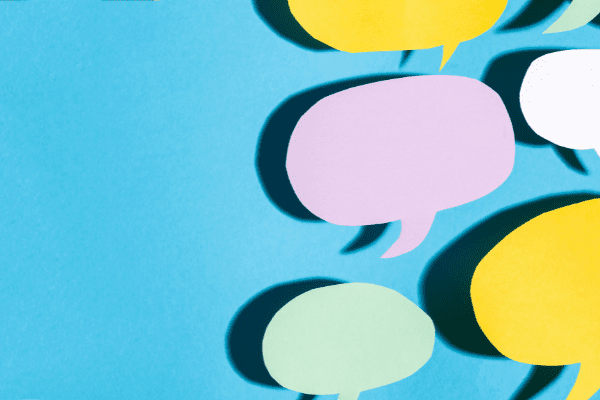
Tips & tricks for quality coding
Before we wrap up, let’s quickly look at some general advice, tips and suggestions to ensure your qualitative data coding is top-notch.
- Before you begin coding, plan out the steps you will take and the coding approach and technique(s) you will follow to avoid inconsistencies.
- When adopting deductive coding, it’s useful to use a codebook from the start of the coding process. This will keep your work organised and will ensure that you don’t forget any of your codes.
- Whether you’re adopting an inductive or deductive approach, keep track of the meanings of your codes and remember to revisit these as you go along.
- Avoid using synonyms for codes that are similar, if not the same. This will allow you to have a more uniform and accurate coded dataset and will also help you to not get overwhelmed by your data.
- While coding, make sure that you remind yourself of your aims and coding method. This will help you to avoid directional drift , which happens when coding is not kept consistent.
- If you are working in a team, make sure that everyone has been trained and understands how codes need to be assigned.

Psst... there’s more!
This post was based on one of our popular Research Bootcamps . If you're working on a research project, you'll definitely want to check this out ...
You Might Also Like:

31 Comments
I appreciated the valuable information provided to accomplish the various stages of the inductive and inductive coding process. However, I would have been extremely satisfied to be appraised of the SPECIFIC STEPS to follow for: 1. Deductive coding related to the phenomenon and its features to generate the codes, categories, and themes. 2. Inductive coding related to using (a) Initial (b) Axial, and (c) Thematic procedures using transcribe data from the research questions
Thank you so much for this. Very clear and simplified discussion about qualitative data coding.
This is what I want and the way I wanted it. Thank you very much.
All of the information’s are valuable and helpful. Thank for you giving helpful information’s. Can do some article about alternative methods for continue researches during the pandemics. It is more beneficial for those struggling to continue their researchers.
Thank you for your information on coding qualitative data, this is a very important point to be known, really thank you very much.
Very useful article. Clear, articulate and easy to understand. Thanks
This is very useful. You have simplified it the way I wanted it to be! Thanks
Thank you so very much for explaining, this is quite helpful!
hello, great article! well written and easy to understand. Can you provide some of the sources in this article used for further reading purposes?
You guys are doing a great job out there . I will not realize how many students you help through your articles and post on a daily basis. I have benefited a lot from your work. this is remarkable.
Wonderful one thank you so much.
Hello, I am doing qualitative research, please assist with example of coding format.
This is an invaluable website! Thank you so very much!
Well explained and easy to follow the presentation. A big thumbs up to you. Greatly appreciate the effort 👏👏👏👏
Thank you for this clear article with examples
Thank you for the detailed explanation. I appreciate your great effort. Congrats!
Ahhhhhhhhhh! You just killed me with your explanation. Crystal clear. Two Cheers!
D0 you have primary references that was used when creating this? If so, can you share them?
Being a complete novice to the field of qualitative data analysis, your indepth analysis of the process of thematic analysis has given me better insight. Thank you so much.
Excellent summary
Thank you so much for your precise and very helpful information about coding in qualitative data.
Thanks a lot to this helpful information. You cleared the fog in my brain.
Glad to hear that!
This has been very helpful. I am excited and grateful.
I still don’t understand the coding and categorizing of qualitative research, please give an example on my research base on the state of government education infrastructure environment in PNG
Wahho, this is amazing and very educational to have come across this site.. from a little search to a wide discovery of knowledge.
Thanks I really appreciate this.
Thank you so much! Very grateful.
This was truly helpful. I have been so lost, and this simplified the process for me.
Just at the right time when I needed to distinguish between inductive and
deductive data analysis of my Focus group discussion results very helpful
Very useful across disciplines and at all levels. Thanks…
Submit a Comment Cancel reply
Your email address will not be published. Required fields are marked *
Save my name, email, and website in this browser for the next time I comment.
- Print Friendly

The Coding Manual for Qualitative Researchers
Student resources, three sample interview transcripts.
The following three transcripts have been provided to help you test your coding skills. Please note these will open in a new window.
Interview Transcript: Digestive Disorders – Brenda
Interview transcript – a teacher’s observations of child oppression, interview transcript: digestive disorders – sam.
The following interview with Brenda [pseudonym] was conducted in April 2013 by Cody Goulder, a graduate student researching people with digestive disorders. Brenda is 25 years old and the transcription is as verbatim as possible.
As a coding and analysis exercise, review the transcript several times to become acquainted with the contents. Make jottings about passages that strike you and pre-code your initial work. Then separate the extended interview transcript into stanzas. Determine the most appropriate coding method(s) for the transcript to help examine the general research questions:
- What are the experiences of people with digestive disorders?
- How do people with digestive disorders cope with them?
Also consider comparing or combining the analysis of this transcript with Sam, the other case interview on digestive disorders.
B: Bowel disorders, it is what it is.
I: How old were you when you first started to realize you were having problems with your digestion?
B: I was, uh, 21 and a half, to be exact, yeah.
I: And do you suffer from celiac or, how would you define your discomfort?
B: My colonoscopy says no celiac and not inflammatory bowel disease. My blood marker test says I have inflammatory bowel disease. I would label myself definitely gluten intolerant.
I: And for the record, can you describe what that means? Gluten intolerance? As you would describe it.
B: Gluten intolerance means that you, your body just does not digest or break down or really absorb gluten. And that is a protein that is found in wheat. I would also say that I don’t handle processed wheat well either. Um, and the symptoms are across the board. For me personally, um, I get, I’ll get joint pains, exhaustion, um, and I just feel incredibly full. After four or five bites, if I’m having, say, pasta or something where it’s just, after four or five bites, I can’t eat anymore, feel nauseous. That’s actually where the symptoms really first started.
I: Was there anything else beyond that? Say migraine headaches or …
B: Headaches. I have, and it’s gotten a lot better, I had, um, pretty bad hormonal acne, is what they would call it. Went across the board trying to treat it. I tried creams and antibiotics, retin-As, all that stuff. When I started to cut out gluten and wheats, my skin cleared up the best it’s ever been. I even went on Accutane and, I was on Accutane for five months and that is exactly when my symptoms would appear. I’ve been completely healthy my entire life.
I: Do you think there is a connection between …
B: Yes. I, well, studies have shown that if you possibly have Crohn’s disease or ulcerative colitis and you go on Accutane, there is research coming out that, it can set those diseases off. Um, and I just, I can’t, I think that’s what happened to me because of, like I said, I was completely healthy and then one day I’m having bowel issues and medications.
I: You said you’ve seen doctors, medical doctors, what was that process like of getting tested? What was the response?
B: Well, I went to, when I first got sick, I went to my internal medicine doctor and he’s like, “I don’t know if it’s acid reflux or what, so I’m gonna do a blood test on you.” And he did a blood panel, that’s when he said, “OK, according to these markers you have IBD, go to a gastrologist.” And, I went to one that was recommended, um, and she was just like, “OK, I wanna scope you.” I told her about all these symptoms and when I told her I’d been on Accutane, she kind of made a look like, “Oh, OK.” And then I have a family history, unfortunately, with inflammatory bowel disease. Both of my younger sisters have ulcerative colitis. I have an uncle who is deceased who had ulcerative colitis, and two or three second cousins that have ulcerative colitis and Crohn’s.
I: Can you describe what ulcerative colitis is, as you would describe it?
B: Um, it’s just your intestines not really absorbing the proper nutrients and inflammation, um, and that can be where, um, in any part of your gut. All the way to, Crohn’s can even burn your esophagus and mouth, all the way down through the rest of your body. It’s pretty intense. I was the healthy one. I didn’t have asthma or, not like my little sisters. The hell they went through in middle school with getting sick, I never had that.
I: Would you be willing to talk a little more about that?
B: So, my first sister got sick right around middle school. Her symptoms were, any time she’d eat, she immediately would have to go to the bathroom, instant diarrhea. She’d break out in a sweat. She’d get [ unable to transcribe ], which is a kind of skin lesion, which is, we talked to the dermatologist and, but until you treat really the underlying problem, you don’t know what’s going on. Um, what else did she have? And just going from doctor to doctor. Um, they did a scope and there was a little inflammation that they did find. Um, but they still were very hesitant of saying, “Yes, you have ulcerative colitis” because she wasn’t on, your typical textbook case. I found that really hard for doctors. If it’s not black and white, they …
I: We’ve discussed in other interviews, before this, the fear of using labels in …
B: They’re terrified. I mean, I went through several doctors and then finally, um, I think kinda, and going through puberty, I and, while my sisters were going through puberty, it was really hard. With all the hormones and changing, It just kinda, I think, throws a lot of things off. And then my sister, she’s what would you call remission, but it’s never really going away. You’ll always still have it, but she been in remission for a while now. Um, found the right doctor and he didn’t label her until he started treating her.
I: So it was sort of a trial by fire?
B: Yeah, we’d kind of tell them, “Hey, can we try this? It’s not getting better.” And then my youngest sister, right around the same time, about sixth grade, she got sick as well. Different symptoms. Um, she didn’t have, she had ulcerative colitis. But, there can come blood when you go to the bathroom. And she went in, was severely sick, she went to the hospital. And filled up the little cup they have, completely, with blood. And when they went in to scope, they couldn’t find anything. But she had the blood. She had the joint ache. She has the rash. She’s trying to eat as much as she could, but her belly would distend. And they wanted to send my sister to the psych unit. They thought it was a mental thing and we’re like, “No, she’s filling up the cup.” Like, really? And it was just their reaction because they couldn’t figure out why because the gold standard in diagnosing these things is the colonoscopy. But it’s so hard with these diseases to find it.
I: Why do you think there seems to be a reluctance or a unwillingness in wanting to just get right to the point?
B: I’m not really sure. I don’t, I don’t know. I don’t know if they’re taught that in med school that, you know, that it’s not black and white. And we have found also that, when you are in a hospital setting, you don’t see the same doctor. You have a doctor for a week and then, you know, in all honesty, they weren’t all on the same page. They had their own egos and their own agendas. My sister was in there 21 days. Still, we were finally like, “This is enough. It’s not a psych problem, discharge her now.” And she was still bleeding, two weeks later, she was anemic. We ended up, by chance, being able to get into a different doctor at a different practice who would treat her as if. She was in remission for about three years, she’s out of it now, but she’s got good doctors. She’s still trying to figure out how to beat this beast.
I: Are both your sisters, and you as well, on prescription medication?
B: Um, yes. My little sister Tammy now, I think because she’s been in remission is on like a, something for acid reflux. My younger sister, she’s not on any medication. And my one sister, yes, but I don’t remember what she’s on.
I: And, none of these symptoms have been shown in your parents?
B: My mom, yeah. I remember growing up and her having bowel issues, yeah. And, it’s all on my mom’s side. My dad’s side doesn’t have any bowel issues. This gluten intolerance thing, I didn’t really understand it until I was taking a class with a friend and I was just telling her, “God, I really don’t like.” They labeled me as having GERD and put me on severe, pretty intense medication. I just don’t like the fact I have to take this medication.
I: What is GERD?
B: It’s similar to the acid reflux disease. So, a lot of it is by diet. Little things can set it off.
I: Before all this, what was your favorite food?
B: I loved pizza and burgers.
I: Would you say you ate a pretty balanced diet? Not loading up on pasta …
B: No, but it’s funny ‘cause when I was sick, that’s all I wanted, you know? That sounded really good to eat bread and crackers.
I: Is that because it was a comfort basis?
B: No, um, I think people with that, like sugars and complex stuff, especially like all the sugar that’s really not good for you, it’s addicting, you know? The longer you are away from it, it’s easier to stay away. Have a little and it’s like I gotta have more. It’s difficult.
I: When you started to cut out gluten and bad sugars, what was the response?
B: From like a friend?
I: Yeah. Were you a partier?
B: No. I was so, no, it was weird. I kinda went through my drinking when I was underage. By the time I turned 21, I really didn’t enjoy it. Actually, last night, I feel it. Like, I didn’t drink that much and I feel like hell the next day. Two beers. But, say if I have food and water with it, it’s still mm-mm. So, when I cheat, I’m like, “You’re gonna pay for it the next day.” But it’s hard. Not wanting to go out with friends and, you know, it gets kinda, after a while, “Oh, I’ll just have salad cause that’s really all I can eat.” I can still eat stuff, but finding restaurants that are accommodating to eating to that.
I: Is there a feeling of being ostracized? Your friends or actually from the restaurant itself?
B: Yeah, it’s complicated. I just tell them now.
I: Do you have a specific experience that jumps out in your mind?
B: Yeah, I’d just gotten, a couple of times when you ask, “Do you have a gluten-free menu?” They’re getting much better at it, but I remember when I first started, like a year and a half ago, it was still kind of like [ rolls eyes ], “Oh, you’re one of those people.” Um, cause some people will cut out gluten because they think it will be great for them. But it really doesn’t hurt them. So, I don’t like to be grouped into that. It’d be cheaper. Probably be easier just to be able to go with the flow.
I: How does that make you feel when you talk to someone who says they’re cutting out gluten for my diet, but they can eat bread if they desperately wanted to?
B: Um, close friends, no. Not at all. I mean, because, well, they’ve seen me not do well. I’m just not very nice either because I don’t feel well. Um, but strangers, yeah, that don’t get it. You know, there’s kind of a judgment and they, “Why are you, are you doing it to lose weight or … ?” No, I’m doing it ’cause I feel miserable. But that’s also something that’s going around like in the media, I know, it’s being hyped up as, “Cut out gluten, it’ll make you lose weight.” I think that anything, if you’re just trying, doing it to lose weight, that won’t stick.
I: How do feel with all the mass market of gluten-free this, gluten-free that?
B: It’s a little overwhelming, to be honest. You really have to look at the food labels. Are they taking out this? I still, and trying to find stuff, um, at the grocery store that I can eat, but it takes forever. I try to, at least, read every label. Grocery experiences are long [ laughs ].
I: Is there a specific thing that you want, but know you can’t have?
B: Yeah, that’s my downfall. I mean, I’ve found some places that are gluten-free. But, you know, I haven’t found, has anyone found a gluten-free pizza that you can make at home, send it my way ’cause [ laughs ] …
I: In addition to reading labels and breakdown what I can and can’t eat in the moment, how has your lifestyle changed to feel comfort?
B: With gluten intolerance, I’ve done some research. But I’ve gotten to the point where I’ve, I’m taking a class with a friend and she’s like, “I have stomach issues. Why don’t you read this book? It’s called Eat Right for Your Blood Type .” I didn’t know my blood type at the time, so I started reading the type-O diet and I was like, “Oh my god.” It describes how, based on if you eat these foods, it’s what you have. It’s so me. I had to kinda look away. Is this really me? And it was. So for me, I follow the hunter-gatherer type, meat, fruits, and vegetables. Um, and so that alone, that book and I’m so grateful for my friend, because that brought a sense of comfort.
I: It sounds like you’ve got a lot of support around you.
I: And, have you been able to pass that along to your sisters? Did they ever talk to you about what it’s like to be in middle school and have, really feel, have these differences?
B: Oh yeah, it was really, really tough. Kids, not so much kids, but I remember the teachers would not, being, not really getting it. And my mom would try so hard to, I mean, “Hey, this is what my daughters have. There are the type of medications, heavy medication at one point that they were on. Heavy steroids that make you, not really there. Um, she’s maybe not paying attention because her pain or she’s trying not to shit her pants.” And, um, yeah they had a really hard time finding kids that understood what they were going through. And, it’s a disease on the inside that doesn’t always manifest on the outside. And I think a lot of diseases are like that. Just being aware.
I: Especially when a lot of the symptoms are connected to other diseases? Are you concerned, have you thought about at all what this could lead to?
B: That’s why I changed my diet because I know the blood markers, so, in some ways that kind of means I’m a ticking time bomb. You know, I could get the flu really, really bad. And that could set off this disease. Um, but I’m doing everything that I can in my power as far as diet that I can to control it. Because that also can set it off. I’ve adapted this new lifestyle. Exercise like three, four times a week. Um, that’s been the hardest one, to really stay committed. I’ve conquered the food part, but not putting in the exercise as well. And doing yoga ’cause I stress easily. And, that’ll feed into it, that stress will lead me into making poor food choices. So, finding the balance is what I’m really focusing on.
I: Do you feel that, when you’ve had a bad day, it’s the emotional connection, or that emotion is tied to reactions? “I feel bad, I need comfort.”
B: That’s something to be aware of, definitely. That’s happened to me.
I: Do you think there’s a danger in people becoming so emotion-oriented?
B: Oh yeah. Um, yeah you gotta find balance you know? And being aware, it’s all kind of connected.
I: Is there a point where you’ve had to battle and fears or overwhelming emotions? And you had to bring yourself back? Trigger or phrases that help keep you in balance?
B: Um, I have to stay in the present. And not, “God, what if this happens?” ’Cause that, you know, will set it off. And that’s where I need to be, in that present and just focus on that. And when I don’t, that’s when it gets me and stresses me out. And in listening to your body is the best thing. You are your best advocate for yourself. Not taking the medical. Being in tune. It’s clear if I’ve had a bad week. I eat foods I shouldn’t have been eating. I feel really lethargic and exhausted. If you don’t want to feel like this, don’t eat it. It’s pretty immediate.
I: Do you feel you’re leaning towards organic?
B: I have found, for me, the hunter-gatherer, animal protein. I’d watch documentaries on how animals are being treated, on what they’re given and what we’re absorbing and the cancer rate and all. So, I tried vegetarian, but that means I upped my soy. A lot of soy, had a lot of grains too, even lentils, which are supposed to be really good. And I felt miserable. And I gained a lot of weight. And, they, “You know, don’t eat meat and you’ll lose weight.” For me, I felt horrible. Like, my skin was breaking out, I gained weight. I think like everyone is honestly a little bit different. It’s unfair to the consumer. I gotta eat animal protein or I’m not a very nice woman. I’m cranky. Watch out! But, on the other side, I’ve got to pay more for grass-fed animal meat that’s not injected with hormones. I think that’s what’s causing the cancer and all these problems. It’s because of what they’re giving to the animals. And the hormones. Of course we’re gonna get sick. Of course. It’s infuriating, it really is. But you pay more, a little bit, for the great meat, you know, versus paying several years down the line severe medical bills. I’m not saying you couldn’t, one day, have cancer. But you’ve done everything in your power to not get it and I just got the short end of the stick, but at least I can be in control of, at least I’m eating this. Holds me accountable.
I: Last question, what’s it been like?
B: I have a really tough stomach. Yeah we, my sisters and I, do talk about it. Definitely check in and, our poor dad. We’re all so females that, sometimes, there’s a point we’re at dinner conversations and we talk about our bowel habits and what was going on. My poor dad. So, yeah, there’s definitely an open communication and you gotta have a sense of humor. You got these issues, you have to have a sense of humor.
I: What would say to someone that provides comfort? It’s OK, this is life?
B: Um, we just, we just joke. “Hey, remember that one time when,” you know? You just have, you just kind of have a sense of humor about it, accepting what it is and try to stay positive is how we try to move forward. And be on top of it. And really choosing to have a say in relation to our digestion and stuff. Being aware. It’s different for everyone. Be in tune with what your symptoms are. You’re your best advocate.
An interview was conducted with “Ms. D,” a female, fifth-grade, veteran elementary school classroom teacher in preparation for an action research project on school bullying. The research team interviewed fourth- and fifth-grade teachers at a lower middle-class suburban school site to learn about forms of oppression they saw and heard most often among their children.
As a coding and analysis exercise, review the transcript excerpt several times to become acquainted with the contents. Make jottings about passages that strike you and pre-code your initial work. Then separate the interview transcript into stanzas. Determine the most appropriate coding method(s) for the transcript to help examine the pre-action research question:
- What are the forms of child oppression?
Also compose an analytic memo that brainstorms the types of strategies that might be taken by an action research team to lessen the amount of child oppression in a school setting.
I: How do children in your classroom oppress each other?
MS. D: Well, they call each other names.
I: Like, what kinds of names?
MS. D: Oh, we’ve got a little girl in here, she looks different and she acts different, so they’ll make up some name that they call her. They, um, it’s the same kid, it seems like every year there’s one kid that gets picked on more than somebody else, because they’re different, because they might look different, they might act different. Say, for instance, she will say something or she gets very excited about something, they’ll tell her to “Sit down,” “Be quiet,” “Stop doing this,” they’re like on her case all the time. Then you’ve got another kid in here who, well he loses control of himself, and so he blurts stuff out or yells out, and the kids will turn around and yell back at him. And out on the playground they do tend to sometimes get pushy-shovy kinda stuff. Like with her [ pointing to a desk ] I’ve watched them actually walk by this little girl and purposely bump into her or something like that, but then even though you’re watching them, the kid’ll turn around and say, “Well, I didn’t do that” after you confront him. And it’s not everybody, it’s just a few, and it’s a few that have behavior problems that seek attention, and they don’t know how to get attention any other way besides a negative way.
I: How do the students deal with these conflicts?
MS. D: They come to me right away to tell me, so then I have to deal with it. I’ve told them to do it that way. I don’t want them taking means into their own hands, ’cause if they do then they’re causing more problems than, because they tend to get physical or it’s a taunting kind of thing that will take place all over the place. So if they come to me right away then I can deal with just the two people it involves and that way it doesn’t tend to get blown out of proportion. It stays right there rather than getting other kids involved in the situation.
I: What kinds of oppressions might your students deal with in their home environment?
MS. D: Oh, jeez. There’s some sad cases here. There’s this one boy who seeks attention because his mother is a drunken alcoholic. The mom says he’s her best buddy and works hard to get him what he wants. He’s had to meet with the school counselor. There was another girl who was taken away from a bad family situation in Philadelphia because of physical and verbal abuse, her mother was into witchcraft. She moved to live with some relatives here but the home situation here isn’t safe either, so the police had to be called in. But she seems to be settling in now. Her mom’s moved down here but the girl’s slowly evolving into one of the neighborhood kids. She’s the one they pick on a lot because she is a little different, but she’s had different experiences than a lot of kids, too.
I: What kinds of differences do kids tend to target?
MS. D: With this one student the kids seem to zero in because she did look different, and she …
I: Clothing-wise?
MS. D: No, just physically, she, she just, and she acted kind of strange, she would just rock back and forth in her chair, that this was a thing of the abuse, that kind of thing. And one of the girls said, “Stop it, stop it!” and I would have to go over to her and just put my hands on her, “Don’t do that now,” that kind of thing, and we had to have her meet with the school nurse. And she’s the type of kid who thinks she knows everything, so that was another thing that bugged the kids, that she would, and yet she does know a lot, but they just didn’t like it, that it was her . You know, once they had this idea that something’s wrong with them, or they don’t like them, then when they start to interact with the kids and the kids kind of, they’re not accepting. But most of the other kids in this room have been together for years, so she’s brand new, the other kid with problems is brand new, and so it’s the ones, they’re kind of not fitting in because they weren’t with this group as they moved on through school.
I: Like a newcomer?
MS. D: Uh-huh, I think it is like a newcomer thing. It’s basically the new ones. These two new ones were pretty outgoing and were put down by the others, but another newcomer moved quietly and she was easily accepted because she didn’t stand out. There’s another boy who’s obnoxious and the class gets upset with him. The kids pick up on attitude. Their whole thing is attention: how can I get attention and bring it to myself? Acting goofy or silly is a big thing, and some of the kids’ll say, “Oh, stop acting like that.”
The following interview with Sam [pseudonym] was conducted in April 2013 by Cody Goulder, a graduate student researching people with digestive disorders. Sam is in his early 30s and the transcription is as verbatim as possible.
Also consider comparing or combining the analysis of this transcript with Brenda, the other case interview on digestive disorders.
I: How old were you when you first realized you had something, celiac or, I should clarify: do you have celiac or is it a variation?
S: And I’ll clarify, too.
I: Yeah, absolutely.
S: A few things: I do energy healing and, um, as well as like, um, counseling of people like with diseases of these natures. So, because of that I also go to medical doctors or energy healers and nutritionists or people more off, off the beaten path, acupuncturists, things like that. And because of that, these doctors are hesitant to specifically name anything, because once you put a label on it, you give it power. You give it a consciousness and the more you, the more that consciousness is spread out, spread around like ADHD and all of that first came out. It gives it a negative connotation, so I was never told celiac. I was never told, the only thing I was ever told was, in the early stages was candida and parasites. And candida is a form of a parasite. Um, and other than that, they don’t address it to me and I don’t really ask. I’ve, I’ve asked, slipped up and asked, in the past, um, the doctors just like don’t worry about it. Because then, I’ll start to research it and buy into the symptoms.
I: Why do you think that is? Aside from not wanting to promote, for lack of a better term, hysteria, why do you think doctors are so reluctant to label …
S: Um, I think medical doctors is because of the lawsuits. Per-, perhaps, and the liability. They don’t wanna, um, but, but the alternative doctors I go to, which are, I mean they’re also chiropractors, so they are doctors. Um, [ pause ] for one of the reasons I just mentioned so that my consciousness doesn’t buy into it and I create more of the disease, within my own body, which I, we all kinda tend to do anyway.
I: For the record, and certainly help clarify because, through this project, we’ve talked to other people we’re interviewing and we’ve heard different labels for it. So, can you help explain the variations?
S: If you went through my symptoms, you would say, you would say celiac. You would say there’s a lot of stuff. And I just saw something on Facebook, um, a medical doctor, I don’t know, I was trying to find it for you. I don’t know whose page it was, ’cause I have so many fan pages. It was a medical doctor that said, “What I used to, when I was practicing medicine, my patients would come to me and they had all these symptoms, which is fatigue, chronic fatigue, like all the, um, diarrhea, chronic diarrhea.” I’ve, you know, chronic stomach pains, intestinal pain, and things like that, um. Vision problems like floaters, um, I forgot what else she said in the list, but it’s like, “Oh, that’s all me.” There’s, there’s no name for that. But, she said, “When I finally would ask my patients what their body needs, because they went through all the protocols and all the testing and nothing would ever change. When I finally asked my patients what their body needs, some would say, you know, this medication or whatever.” That’s a small percentage of what this host said. The rest of the people, 98% would say I need to quit my job. I need to go do something that makes me happy. My body needs this. My body needs, you know, and it wasn’t related to anything that, food-wise or medical-wise, it was related to lifestyle choices. And, as a healer myself, that’s what I’ve learned as well and, you know, knowing this I should be able to heal myself and slowly, slowly, gradually I am. But, it’s, it’s easier said than done. Especially when you’re dealing with something that’s so emotionally tied into your, your system and your psyche. Does that make sense?
I: Yeah, it does.
S: And that kinda follows through with what, when I’ve started reading into the candida years ago, I was first diagnosed.
I: Can you explain a little more about candida?
S: Candida is a yeast infection. And, when I first heard that, I’m thinking “Oh, which chick did I get it from?” [ laughs ] And so, I started like, after a while, after about a week, I’m like, you know, I’m gonna google this, and what it is is, we all have this natural yeast that occurs in our bodies. And, what happens over, it could be a traumatic issue. A traumatic occurrence or a thing like that, um, that happens in our lives and that yeast will, will, like, say we have X amount of yeast in our system. Let’s just, naturally good yeast. Quote unquote, good yeast.
I: On par with, say, the good bacteria living in our stomach.
S: Right. Well, when that good yeast expands to like double X or triple X or however, I’m just, I’m not, um, when it expands, that level, then it starts to become bad yeast. And it starts to take over and, it’s not, it’s only bad because it’s too much of it. And that yeast will affect your ability, and then the more sugar you have, the more you feed the yeast. The more gluten you have, the more wheat, the more things that, you know, have gluten in them, the more you’re gonna feed it. Um, and so forth until you get to the point where it’s like, you can, and I’ve read the diets and the diets, you can’t even, it’s almost impossible. They say it’s almost impossible to do. You have to do this diet to, to cut out all the yeast, you can’t even have carrots.
S: ’Cause of the sugar. But, then they say carrots are iffy because carrots also help kill the bacteria. It’s like there’s so much unknown about this, but it’s said it’s all, but the consensus that, I googled of all these websites that talked about candida is, it’s all emotional in origin. Hippocrates said the same thing. He’s the father of, you know, modern Western medicine. He said all disease is emotional in origin. As a healer, I know this. Because, even cancer starts as an emotion. And the more that emotion manifests, you get a tumor or something negative. Um, and I full-heartedly understand how that works. Because, especially in dealing with patients and myself, it’s like as soon as you get rid of that emotional counterpart, the disease goes away. Even if it’s cancer, I’ve seen it happen. They say it’s pretty amazing. Um, so, I’m sorry, what was your question?
I: What was candida?
S: Yeah, so, that’s what candida is in a nutshell. And so, that’s what my doctor started treating me for. My doctor, my healer, doctor, chiropractor started treating me for. And, and she told me to cut out all of, and this was probably about in oh-five [2005], it was about a year after I graduated [from university], getting my master’s. Um, it was, she treated me, she said no sugar, no caffeine, no dairy, I couldn’t do dairy either and no gluten, obviously. And, gradually I slowly weaned myself off, ’cause she was a vegetarian at the time, I slowly started weaning myself off of meat and stuff. I did eggs for protein. And what ended up and, I believe this was still, this was less than a year, about a year after my mom’s death, which was devastating for me, and I think …
I: What did she die of?
S: Oh, I can tell you the whole story. Can I?
I: Absolutely, we’ll circle back.
S. Yeah, um, and I believe that’s what started this manifestation in my stomach and my, my intestines ’cause I can tell the difference now. After a bowel moment I can, I’m just worn out. Um, so it was a year after my mom died and I went off all these things. Did the eggs for protein for about two months. I lost 40 pounds of muscle. And fat, but mostly muscle. So, I went from a size extra large shirts to mediums.
S: It was bad. It wasn’t, and I was also in depression and that’s why I want to preface that because I believe that depression plays a part in this all. Is that, whether we know it or not, you know?
I: There’s different levels of depression, period.
S: Exactly. And, there’s, and then there’s the fears that I constantly face like, within myself, and I think that contributed to it. I notice that when, like this HOA [Home Owners’ Association] thing and I think, I thought it was perfect that it was coming up. I hate the HOA, just like you were saying. And I was, I don’t know why I was having such anxiety over this meeting, ’cause once I had the meeting, it wasn’t a big deal. But like, there are certain people that I thought were going to be there, and that weren’t there, that I was like, I don’t wanna deal with these assholes, right? So, that, and that, and I was paying attention to what was happening, having anxiety this past week and it was going, it was going right to my gut. And, I’m like, well that’s not good for me. What am I doing to myself? But, like I can intellectualize it. But it’s, but until I like either do meditation or just like breathe and just get it through my system or just face it, which is what I did today, I, that’s why I went to the meeting, um, until you face that fear, you can’t, it’s almost impossible to get rid of it. Because once you face your vulnerability, that’s when, that’s when you empower yourself. But, most people are used to running away from their vulnerabilities. Does that make sense?
I: Absolutely.
S: So, OK, you wanted to go back to my mom or, I kinda jump around so keep me …
I: No, it’s fine, I like to jump around. Um, so how does, let’s backtrack a bit to candida, trying to get a scope of these disorders?
S: I can tell you how candida manifested into other things if you …
I: Absolutely. Oh totally. Yes, so how does it differ from, say, someone who has celiac or has a general gluten or lactose or … ?
S: I think people that have celiac I, don’t quote me on this, but I, well, you can quote me on this.
I: I don’t have to use it.
S: I, I’m pretty sure people who have celi-, celiac also have candida issues. I’m pretty sure and, you know, chronic fatigue plays into all of that. I’m pretty sure that people who have gluten intolerances have the celiac, whether they were tested for it or not. I’m not sure that most medical doctors, some of them do ’cause I’ve been to a few that do, will test for celiac. There’s a spit test you can do. There’s all these other tests you can do that are, that don’t cost money. But how does it come, go into play?
I: Is it sort of like …
S: I think it was, for me, I think it was the first stages. Um, at least as far as a diagnosis goes and my doctor slowly started treating me for celiac. Once she got that under control, then we started treating me for, like, if I have gluten I’m bleeding out my, you know, out my ass because, and I didn’t know that’s what celiac did. Because, my friend works, he’s a higher up at [a restaurant] and he works in the kitchen and he’s like, he’s like it’s very serious. In like, really, ’cause he, everyone calls it celiac ’cause it’s more widespread as a diagnosis and that’s what we label it.
S: In all intents and purposes, you could say I have that, but I don’t like to use that label.
I: Is that because you feel that, as a medical term, celiac is an easy way to create an umbrella over these conditions?
S: Absolutely. Its, it’s just like, back when they used to say ADD and ADHD they would come up with all these initials for that. You remember those, when that happened?
S: And I’m just like, that was us growing up. I was an A student, but it was still, we were, my little brother was way even more hyper. My mom didn’t know what to do with that. But she didn’t drug him because she didn’t want to deal with him. She just dealt with it. And now we call it something so we can put someone on drugs. But it doesn’t help them. You know what I’m saying, it’s like toxic to those kid that grew up, and now they’re adults, a functioning, and they’re like, that was the worst thing you can do to a kid is put them on the drugs, because they can’t access, access their creativity.
I: What are your feelings when you see gluten-free diets, everything’s being marketed as gluten-free this, gluten-free menus when you are in a restaurant?
S: I actually, honestly, I appreciate it. I don’t think of it as, as a bad thing. Like, what is it, on Picasso’s Pizza, Pan Gusto’s Pizza, which is one of the old Picasso’s, they’re, almost all organic and all gluten-free. Organic, I think, fits into it. If you’re gluten-free you’ve got to watch the pesticides you’re putting into your body. Um, and diet, we’re learning more slowly as a society that diet is the best, is a better medicine than actual drugs. Um, it’s what you put into your body, not just the preventative, but um, as a way, that when you do have something, as a way to get out, get yourself out of it. Um, and …
I: Because food is something that you need and you cannot operate without it.
S: Right, right. And if you’re eating stuff that is attributing and continuing exacerbating the issues that you have, whether it’s emotional or not, I mean there’s still, there’s something in your system that’s exacerbating the problem, then how, how is it that any amount of medicine or anything else going to help you? But if you eat stuff that promotes the good stuff to occur and helps you, help you feel better, helps you to feel more energetic and have energy to exercise, that alone and just a better outlook can push away most diseases in anyone’s body, whether that’s gluten or anything else.
S: Um, there’s so much more I was gonna say because, like, as I’m talking, I’m having all these thoughts.
I: If it comes up to you, just throw it out there.
S: I can send you some stuff from like, I see this happening on my pages every day. Like Socrates or Plato or like all these people or Doctor Freud.
I: That would be amazing if you were …
S: It’s some amazing stuff that, like these are all on my feeds that I hit “Like” on. But, it talks about like, all this stuff in different ways. And they, it’s just …
I: Are they posted on your Facebook page?
S: No, it’s just my feed.
S: Various feeds. And so, you know, as it comes, I’ll just forward it to you.
I: Absolutely. I’d love to see these.
S: OK. And, some of them I save and some of them I don’t. If I have any on my computer, I’ll just, yeah, because, and I’ll, it’ll help your, I think it’ll help your [research].
I: I think it will help this project a lot. Um, and just having information too, to know more about …
S: I mean, and you could hear me say, as a healer, like, when you hear other people that are famous, it’s almost kinda almost …
I: Well, it’s refreshing, I mean, it’s refreshing to get it from your perspective because, as you described it, a doctor is going to tell me something that I …
S: And I was at a doctor, um. OK, there’s something I wanna say and it’s all coming out at once, I was …
I: Take your time, we’re in no rush.
S: My, my chiropractor sent me to a doctor because she’s like, “I can’t prescribe medication but I really think, to kick this out of your system, we want to prescribe this,” and she told me that, what she wanted. So, she sends me to a person I know and a person that she knows and this doctor was just, she was a medical doctor but a quack. I’m just like, “You don’t know anything.” And, I’m like, she was testing, which is fine, testing me for all these, testing my blood, testing my liver and all this. And, she’s like, “Well, I don’t know what to do.” I’m like, “What about that medication, you know, doctor- she suggested?” “Well, I could put you on that and I think that’s the best thing, but I just don’t know what’s going on with you.” And, I’m like, it’s all like going back to the medieval days for me. It’s like, I’m like, I spent time with my doctor and we’ve been treating this and we want results to just kick it. But, she’s all, doctors have that ego. Like, “I’m God, I know better than anyone.” And it’s like, so I took the drugs. Literally, it happened Friday night until Sunday evening, I was in-, I was incapacitated. I’ve, I’ve never been, I can’t call it sick, I think I was in a coma. I could, the only thing I could do was get up to pee, I couldn’t even get water. It was, and what happened was, what I researched and what my chiropractor kind of already knew, she’s pretty intuitive, is it killed a parasite in my liver and it caused that reaction. Now had I known in ad-, had I actually known this in advance, and in hindsight, there’s a tea you can drink that’ll counter that and I would have been fine. But, you only know this stuff through experience. It’s who’s, and this is funny ’cause my mom was the same way. She would educate the doctors. And all my, all my uncles are doctors. Um, so my mom had, she, she was gluten-free later on in life, um, because of her, she had rheumatoid arthritis. But, mostly she, she got on a healthy diet because of the arthritis. She would educate my uncles in treating their patients. She’s like, they would argue with her, “This, this is not what we were, the medical books say this.” And, finally, like after, I was, I was a little kid going to [city], that’s where my cousins are. And that one year, they just switched. My mom was just so beside herself, “I’ve been saying this until I’m blue in the face, what made you see the light?” They’re like, “Our patients are demanding it from me.” And so I had to study it and learn that food is more important than medicine in a lot of cases. You know, you’ll never get them. They’re my uncles and I love, they, but they’ll never say that out loud. Because that’s just, it’s their careers and the, it’s the insurance companies. And I’m, I’m doing all of this out of pocket because my insurance company won’t pay for what I had. I got rid of my insurance. They wouldn’t pay for it.
I: Why wouldn’t the insurance company cover that?
S: They won’t pay for a chiropractor, they won’t pay for a nutritionist. They’re just something society doesn’t deem as important. Some insurance companies will. I have Blue Cross. And after, after several years of, after paying my, you know, paying my doctors out of pocket, I’m just, why have insurance? You know, and so my dad would get back because he’s an attorney, he was an attorney. And he would just, so he would pay it for me. And when he died, I was, just would, my dad, he cancel. [ slight laugh ] Because he had, but that’s because, how he was raised. They were taught growing up, is, you know, from grandparents and aunts and uncles that grew up in the Depression. You need insurance. You need this. You need that. And, this is how you live. You live in fear of the what-ifs.
I: That’s going to happen, you may need this.
S: And I, and what helped me change that attitude, because that’s how I was raised by these people. My dad, my grandfather, what changed, my mom wasn’t like that. She was the artist. She did a lot of coppers, but she did a lot of painting as well. But, um, that’s what she did later on in life. Artistic career. And then she became a realtor in the 80s. And that’s what she did until she, and then she kind of retired after all that, when they moved to [a new location]. But, um, so that’s what she did. Where was I going? I forgot what I was talking about.
I: We were discussing, where did we, we started with celiac umbrella term, and, last little blurb. Insurance. Why did you need insurance?
S: And so, I guess we were on a, a track. I was just saying that, you know, we train our society to grow up in these fear modes. I feel that the fear that you have like, that creates the fear of the what-ifs creates more of that happening. Like, what if my house flooded or what if there’s a tornado? Well, those are the people that attract that most to them. And I’ve known, just from my own experience that if you were to ask me this 10 years ago.
I: Is there a specific experience that jumps out to you?
S: Of me creating my own situation?
I: Or seeing it in someone else?
S: In my dad, yeah. He would create these fears and they would happen. Just like, if I didn’t have insurance then I’ll, then you look at someone like me who grew up in the same family, and I don’t have insurance, and even my doctor, my chiropractor, she doesn’t need. She’s like, “Sam, if I could live like you, I would. But, I still have that fear of society. And if you can let that go, if something happens, it happens.” But, if not, it’s, I, it’s like ever since I saw the movie, and I don’t, I’m just gonna throw this at you. I saw that movie, this is as I was going to join [a university degree program] and I, I didn’t want to bring up the girlfriend. She was a [student in the degree program]. Um, but she, she and I were going through a, insane shit. I won’t go into it, but if we …
I: I want you to know that this is a safe place, so if you want to go on a tangent, throw something out there, go for it.
S: Yeah, you could write my life story later, but I, this will [ laughs ], her and I were going through a, um, emotional upheaval that we’re told, um, ’cause we didn’t know what to do. I mean like, shit was, shit was flying around the room. It was like that kind of, like a, um, looking back was an emotional thing. It manifested itself in, there’s so much we don’t know. [ laughs ] That’s another conversation.
I: That’s another conversation for another project.
S: A major conversation. Um, it’s a major conversation. Not because it was personal but because um, but that kind of tied into it as far as, um, her and I saw this movie. I think it was separately because we were breaking up at the time.
I: What was the title?
S: It’s a famous movie. You’ll know it when I tell you it. It came, I can’t think of it. Not The Secret , the one before? [ pause ] But, anyway, it’s this movie, before I’ll, I’ll get it to you.
I: We’ll figure it out after …
S: If I IMDBed [Internet Movie Data Base] it, I’d find it. It’s a documentary. And once I saw that documentary, after this documentary, I’m like, this is stuff I knew in high school. But I would never say it because people thought I was, would think I was crazy. These were scientists that came up with all this stuff. Not gluten people, right? Um, and in the second half of the movie, it was just like, it was more story with Marlene [ sic ] Matlin in it. And, you know with, the deaf one. And you see her like taking all the drugs in her medicine cabinet and throwing them out because it was, it was her realizing that power not to need that. And I used to take Advil all the time for headaches or whatever. Especially going through [university], you understand how that is. I’m just like, you know what, I had such a rush of, after watching that movie, I took, I even threw out my Advils, and I’ve never needed them since. And so, that’s kind of, that’s an example of where I don’t need that insurance, I don’t have to go buy it. And, if I ever do have a headache, which is probably like three times in that eight-year, nine-year period, very minor.
I: Let’s tie it back to the food issue, because one of the theories running around out there is because so much of the food we consume is this genetically altered …
S: Monsanto.
I: Monsanto. There’s, corn is completely different, the amount of steroids and things they put into beer and chicken. Even the treatment of animals is a hot topic issue. It’s all over the place. How much of that do you think ties into these fears that we have? What I put into my body?
S: I think a lot of it does. The people who are against Monsanto and the pro-organic, whenever you’re against something you create a fear. So if I’m saying I’m against, um, non-organic food or I’m against GMOs, well then, you create that fear that these things are bad. I’m not saying they’re bad or good because I don’t know. We haven’t done enough tests on Monsanto. But by creating that fear even we, it’ll even get in my head that it’s, well, I’ve got to be careful I don’t buy GMO. Then, the more I create that myself, I limit the foods I can’t eat. You know, at least in my mind. In reality, could I eat Monsanto and probably be fine? Probably. But, if I knew it was and I was eating it, that would exacerbate the food. I mean, that would exacerbate the food I’m putting into my system. And, I’ve noticed within myself, if I’m focusing on negativity, if I’m pissed off at someone or in a situation where I’m pissed off and not eating, it’s just, I’m gonna, I’m gonna have diarrhea that night. It won’t be the next day, it’ll just go right through me because I’m eating with anger. Doesn’t that make sense?
S: I mean, I’m not sure how much you’re into this.
I: No, this is all good, I mean, we’ll cycle back in and through.
S: And these are all things I’ve learned since, it was either taught to me sometimes or either, but mostly, the way I’ve learned is, and I’ve always thought this was odd, especially going through [university], I would have a revelation or an epiphany or I would have the experience, learn that way. And then, maybe like a week, a month, a year later or two years later, I would have the validation. I mean like, why is that happening? But, I realized because the, it comes from a book, it doesn’t have as much power as coming from me having the experience first. And then I’d have the validation later. Because, I think, I’ve grown up very skeptical of all this shit, trust me. Even though my mom was very into health food, you know, tried to instill that into her children, it was still kinda feel like, oh, that’s just mom. That’s how we are with our parents. So, but because of my own experience, I’ve been able to develop my own ways of doing things, whereas if someone tells me something, then I’m just kind of like a puppet. Being pushed around and the, with the food industry, with Monsanto, people saying pros and cons. And as much as I try to stay out of that, you still see it on Facebook. It’s because of the places that I hit “Like” on.
I: Getting back to the experiences, I wanna circle back into your background, um, how old were you when you first …
S: Had stomach stuff?
S: [ pause ] Here’s where it gets interesting. I believe it was, if I could trace back all the symptoms, I believe it was probably like, when I was, um, probably in my 20s, maybe 21, 22. I remember talking to a friend on the phone, going and asking like, “Don’t you just feel like wiped out after you go to the bathroom? You know have a, have a bowel movement?” And he’s like, “No.” ’Cause I used to work out a lot back then and I’m like, and that happens to me now where I’d have a bowel movement and I’d just, I’d just be exhausted. I’d have to take a nap. I mean, literally, take a nap. Um, and, but no one, who’s to know back then? No one talked about any of this stuff so I wasn’t aware that’s what’s going on. So, I would say probably around 21 is when I felt it started. Um, now, going back before that, when I was in college at [a western university], 18, 19, 20, or maybe even in high school, I drank a lot. And I’m talking Jack Daniels in one hand, Bacardi in another and have a couple of beers for chasers. And the reason I elected to be social, it was because, it actually didn’t make me drunk back then. I would be the designated driver and I was drinking that much. Because people were like, “You’re, you’re sober.” After a while, I stopped arguing with them. My blood alcohol content probably didn’t say that, I could function, yeah. So, I just drank because it was the thing to be social. I think, in the physical world as opposed to the emotional world, I believe that is what helped destroy some of the good lining in my stomach, the bacterias. And I believe that’s where it started. Because one, every year in the spring, this time of year, March, April, May, a month, I would have a stomach issue. And that started so, so the symptoms started when I was 21 with being exhausted after the bowel movement. You know, like, 25, I’m back from school living here. 25, 26, I would notice, like every year, for about four or five years I would have these issues of one-month stomach issues. And that’s exactly what I’m currently going through. Um, and then like gradually, I would have like acid reflux, and so I would take whatever people would, and it always exacerbated with alcohol. So finally, and that’s why I don’t drink too much. I can go six months to a year without drinking a drop. You know, it just depends where I’m at. Because, I know it’s going to re-effect it. Just from experience, I try not to put the thought in there and it doesn’t.
I: How’d that change socially? Did you notice a change at all? Was there?
S: Socially, I had to make, I had to make the, I had to make this decision to stop drinking. And when that happens people feel, like you think your friends are just like, “Oh, c’mon,” it’s really like a tug of war. It’s like, why is my drinking affecting you? In me going through that, it made me a stronger person. In that, like, per-, pressure way. And even the gluten stuff is like, some friends of mine I can’t even be gluten-free around. It’s like, I won’t even eat dinner with you. Sorry. ’Cause it’s like, especially if I go over to their house …
I: What is that conversation like?
S: Most of my friends know now, but like initially, certain friends, especially the ones from [a western university] that aren’t sensitive, mostly guy friends: “You’re fucking weird or pussy,” stuff like that. It’s like, it’s kinda like, “Oh, c’mon.” And I’ll even drink water that doesn’t have ice in it. I thought my mom was crazy growing up, doing that. I couldn’t do that. But my doctor even said, “Don’t drink water with ice in it because what it does is, it makes your stomach and your system work that much harder to digest the coldness and make it warm, room temperature again.” So, if you already have digestive issues, and I take …
I: Don’t they say, in certain diets, that if you want to lose weight you should drink cold water? One of those little tricks that they tell you? Same with eating peppers.
S: Peppers actually do help me. Certain peppers with the intestinal lining, which wore away gradually due to, they call it leaky gut syndrome. And like, all the toxins within your stool with, be passing through. You’re supposed to absorb the good stuff and the toxins go out. Well, all the toxins were getting into my blood because the gut lining was so thin it started going through the wall. That’s what they call a leaky gut, which was contributing to the, um, chronic fatigue. Which I, and I don’t like to label it but, for me, it was chronic fatigue. Back to what your question was, I’m sorry.
I: How it affected you socially.
S: Um, so socially I, I don’t, I don’t go to bars and if do it’s tough.
I: What specifically? Is it just the …
S: Because one, I’m not drinking this. But two, because most bar food is fricking fried and it’s got gluten in it. And, even if it’s not fried, it’s not the most healthy, you know? So, my choices are eat beforehand, meet people, sit around and talk while they eat and drink and, you know, you can still have fun. Like, I have friends that are alcoholics who, you can still have fun and, but you can’t, I mean, I just gradually stopped going. Dwindling, so socially, it’s like, to answer your question it’s, I’ll just tell you, I literally, I haven’t lost friends, but I don’t hang out with them as much as I used to. I mean, not nearly as much. I was out every night. Now, it’s sometimes once a month.
I: And that’s not something one can find, almost like a support group or …
S: And, it’s one of the things I was just gonna address which is, it’s almost easier to say, “I’m an alcoholic” than “I’m gluten-free.” It’s all easier to say, “I’m an alcoholic” than say “I can’t drink alcohol because I choose to not drink alcohol with you.” Because when you’re an alcoholic, people like give you that respect. That just is. But when you’re, when you make a choice for your health, to eliminate something out of your diet, it’s like, it really affects other people. And I had to learn that that’s not my issue. Just because you want to drag me into your hell doesn’t mean that, and I had to learn that, how to be strong enough, to stand up for my own health, really. And that’s what it boiled down to. I mean, literally, and one of the guys I’m talking about, kinda referring to is, I see him once every year or six months now. We used to hang out all the time. But because he couldn’t let go of that, and even with his daughter, she, he had a three-year-old who’s had issues with gluten. And I, we were out at dinner and they order it special, non-dairy because no dairy ties in with gluten. As well as alcohol and all that stuff, sugar. Um, and he, he was getting on her, and his family’s practicing medicine too. His dad and uncles are doctors. The words that came out of his mouth were, “I want her to eat normal cheese because I don’t like it.” So, I can live my life and I’m just thinking, and I don’t like, I don’t like to chastise my friends ’cause that’s their choice how they want to raise their family and live. ’Cause, I don’t want to do to him what they’d do to me basically. But when they say that, it’s like you’d rather put your daughter on drugs and medicine that might affect her later on, at three years old, than just get her off gluten for a while? And have her just be healthy? So, I don’t know, it’s for me. And I see her face too, it’s the irony of that. And it’s kinda like that lady, Louise Hay, who I think it was from 73, 75, she made the decision, not because of her health, because of her health, but not because she was gluten intolerant or anything like that. It was a decision before it was even popular to do no sugar, no dairy, no alcohol, and no gluten. I think no caffeine too, like there’s those kind of four or five things that could kind of contribute to the issues. She’s almost 90 right now. I mean, and that’s amazing in our society and she’s got her own publishing company.
I: Especially when it is not with the assistance of a plastic heart. Or something that has been artificially put in.
S: Exactly, so, and there’s probably everyone for her age, there’s probably other people that are smokers and, you know, do drugs all the time. So, who knows? I mean, I’m just saying, yeah right. Anyway. All these things they’ve found for cures have also proven harmful to your system. So, she actually wanted to learn how to be able to get out of bed during the day because of her arthritis. Because of the gluten at the time. The more she looked into the diet, the more she researched, she learned gluten could affect it all. Back then, all it was was rice, bread, and that’s it. It’s better for me to have brown rice than white because of the nutrients. In the food aspect, I’ve gotten to points where I’m like, I don’t want to eat any more. Like, literally, I, my situation is probably different than others. I eat out almost all the time. I will eat like raw foods, which I’ve found is much better on my system besides processed foods.
I: What is your favorite kind of food?
S: I don’t eat pizza anymore, unless it’s from Picasso’s because they do a great non-gluten, non-dairy pizza that tastes great.
I: Were you a big pizza buff before that?
S: I ate a lot of pizza. I knew it wasn’t good for you but I did it. I mean, it’s cheap. I would eat Taco Bell a lot, and there’s things that I would do in college that I would only do in college that I wouldn’t do when I was out. And that was smoke pot. Although, I didn’t really inhale. As soon as I graduated, I was done. If you put something in your system, make sure it’s good. My dad connected that with gourmet. My mom, she said organic. I like seafood. Just have to be careful it doesn’t have a thickened sauce with flour. Afterwards, no pizza. The dairy will affect me as much as the gluten, if not more. Sugar’s been the hardest one. I can cut it out and be cold turkey. But the little increments I can’t do. Sugar also contributes to cancer. And, they’d rather fight cancer with chemo than do it the right way. The candida was the first thing that we addressed with my treatments. And that was over the course of maybe six months to eight months. Maybe longer, I don’t know. This is my memory. But then after that, we started treating me for parasites. Whether it morphed or it’s just, I think she was doing the stages.
I: And this is when you were seeing the doctor?
S: The chiropractor. And this is all out of pocket. I was seeing and what literally brought, OK, I was seeing her and she got me to a place where I was stable. I stopped seeing her for about three years. Um, I came back to her. It was hard for me to come back to her, not because I didn’t like her, but because, um, I had gotten to a point where I, I would wake up in the morning, go to the bathroom, like you know take a shit, and I was exhausted because like, literally, it was my gut was leaking. So like all the toxins were coming out through and it would burn and it, it was like draining. I learned that your stomach is your power center, it’s where you hold most of your power, and if that’s affected, you’re wiped out. That’s from my experience, I found out research that proves it, but I, or otherwise I’m just telling you what someone else said. So, I’d wake up in the morning, take a shit, ah fuck, go back to bed. I’d get up. I’m like, my God, I’ve gotta eat. I, get this, this was going on for weeks. I’d get up, go downstairs, grab something out of the fridge or out of a cupboard, eat some food, that would wear me out. It’s like it’s wipe me the fuck out. And I would go back to bed. Then I would take a shit. Like, this was throughout the whole day. I would stare at the ceiling looking, thinking, really start talking to God, “Why the fuck am I here? If you want me to, like, what do you want me to do?” It’s like, it’s like you have that conversation and it’s like, just kill me or take me, you know, because I don’t know if I can, if I can’t function, then what’s my purpose here? I can write about this, but I can’t when I’m exhausted. So, I got to this point where I’m just like I have to go back to this doctor. Literally, like, she won’t say anything. She doesn’t want to alarm me, and she knows me, ’cause like, we had this understanding. It’s OK, don’t tell me. Um, literally, she had to treat me for parasites. For all this stuff and she would gradually do it, without explaining to me the process. And I never asked. I didn’t care, because it’s like I don’t want this part to interfere with this part of, you know? If that makes sense? The mind and the stomach. Um, so I started seeing her and literally it was like, but I knew I was ready to die. And she’s like, “You, you’ve had this for a long time” and she’s like “We’re past the point of me treating this for you. You just felt good and stopped seeing me.” OK, I get it. I started seeing her again and like stage by stage we’re treating me for allergies. For gluten allergies, for, I actually started getting some arthritis symptoms here and there and they’d go away once she started treating for, um, for arthritis. She treated me for leaky gut. But you can’t do it all at once. Gradually you can, but she wanted to treat one thing at a time, to make sure it was working. And it was, but, you like, she comes from an engineering background before she became a chiropractor. Intuitive. Nutritional. So we stated with candida, then we would treat me for parasites. Then we would treat me for allergies. Food allergies. And then something emotional would happen, and it would be just like, I’d be back at square one. Not square one, but it felt like I was back at square one. And, when that emotional situation would happen, I can’t remember specifically what incidents back then, but something would set it off and I would either get pissed or all my symptoms started coming back. It can be a physical or emotional stress. My triggers are people attacking me with words. It goes right to my gut and I haven’t gotten past that sensitivity, especially when it involves anger. So, I understand the emotional part. Like people aren’t making this stuff up. How can you agree with one part they say and not the other? People are nuts, man. It’s like you have to do what works for you. When you’re living in a hole where everyone wants to tell you what to do, they don’t know your system. The only one who knows it and can empower it is you. I’ve learned to be stronger, to be able to walk with more confidence as opposed to going around life getting pushed around like a pinball machine. No matter what kind of people try to steer me off course. It’s harder to talk to myself because then I have to listen to this shit. It’s easier for me to explain it to people. I get that. More full life. More satisfaction in life. We always want to be better than our parents and have our children better than us. I’m more in tune with what I’m doing. I’d rather not have gluten at all and cheat after a while. When you have too much of the same food, eventually, your body will reject it because you’re not, it’s just the tolerance for it decreases. Just like the antibiotic. I would take antibiotics to get rid of lingering stuff. I didn’t know there were natural cures. My mom would always say, “All the doctors I go to tell me, only do antibiotics if it’s life or death.” Why wouldn’t they have medicine if it wasn’t good for you? Immunity. I’d done way too much. If I had a fever, I’d take a hot bath, then I’d start throwing up and that would be enough to kick the system. It’d burn my stomach. It was alcohol, it was antibiotics, it was whatever was destroying the lining. I didn’t learn how to express my emotions as a child. We hold our emotions in our gut.
[The interview continued but the participant addressed content not related to the central research question.]
Transcribing interviews for qualitative research

Transcribing interviews is an important step in qualitative research, as it forms the backbone of data analysis and interpretation. In other words we can say that it acts as a vital link between those unfiltered conversations and insightful data acquired from them. But why is accurate transcription so crucial in qualitative studies?
The fundamentals of qualitative research itself provide the first justification. The depth with which linguistic expressions and emotions are communicated during interviews is crucial for this kind of research. Accurate transcription ensures that these non-verbal cues are also added for more clarity.
Transcribing interviews qualitative research is essential to ensuring the correctness of findings because it enables researchers to fully capture the range of participant replies and perspectives. Moving forward in this article we have compiled a comprehensive guide to help you get a more clear perspective on how to transcribe interviews for qualitative research.
What Is qualitative research?
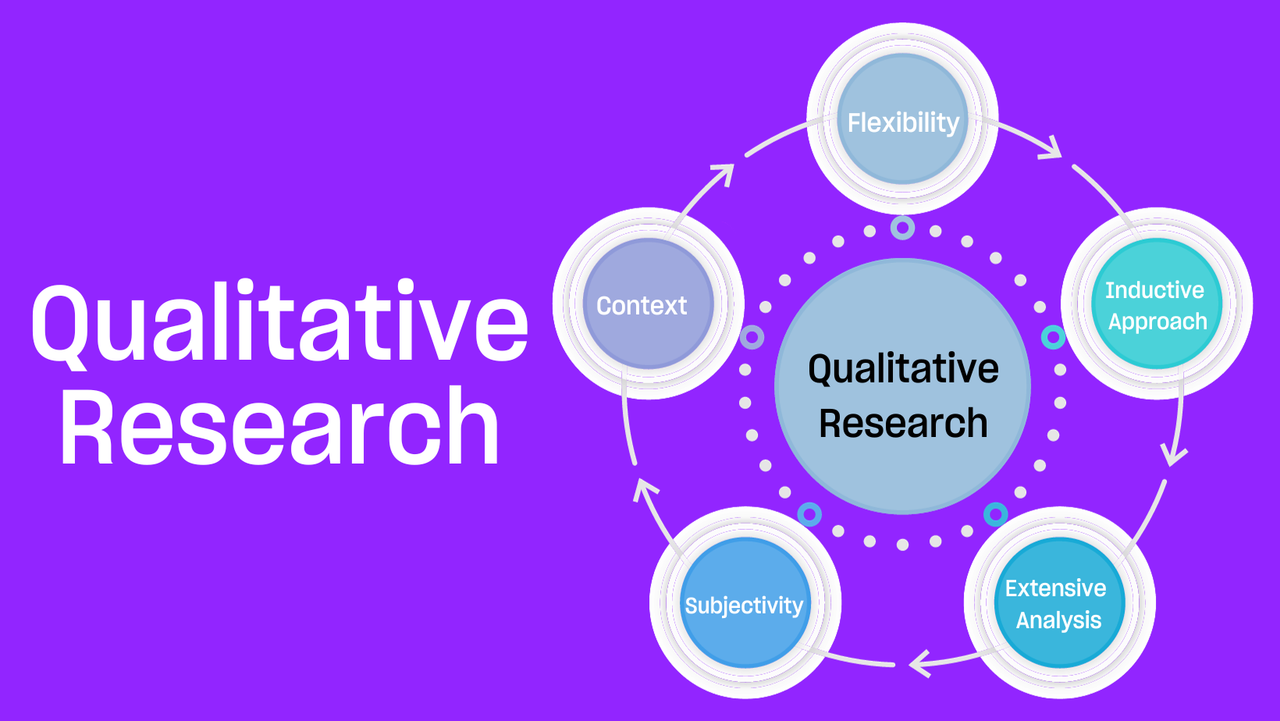
Qualitative research is one of the most commonly used research methods in the field of academia. Instead of concentrating just on the what, where, and when of decision-making, it explores the why and how by focusing on the human aspects of a specific issue or situation. It aims to comprehend people's experiences, actions, feelings, and the interpretations they place on objects.
Getting a much deeper insight into people's attitudes, actions, value systems, concerns, motives and goals is the main aim of qualitative research. It is employed to acquire a deeper comprehension of intricate occurrences that are challenging to put into numerical form.
The main characteristics of qualitative research are:
- Focus on context: It explores the context in which behaviours and events take place.
- Subjectivity: It recognises the subjective nature of the study and frequently captures the perspectives of the participants.
- Extensive analysis: This entails a thorough examination of a limited number of case studies or circumstances.
- Inductive approach: The inductive approach often begins with observations and builds theories from them.
- Flexibility in design: As the study goes on, the research question format may change. Here it is not necessary to follow the predetermined context.
Researchers use qualitative interview as their main method of data collection for this research since it allows them to interact with the subject first hand and focus on the non-verbal cues along with the information they are sharing.
Looking for support in transcribing your qualitative research interviews? Good Tape offers transcription services that can help you better understand your interviews. We're here to help make your transcription process more manageable and efficient. Explore how Good Tape can assist you in your research endeavors .
Qualitative vs quantitative interviews
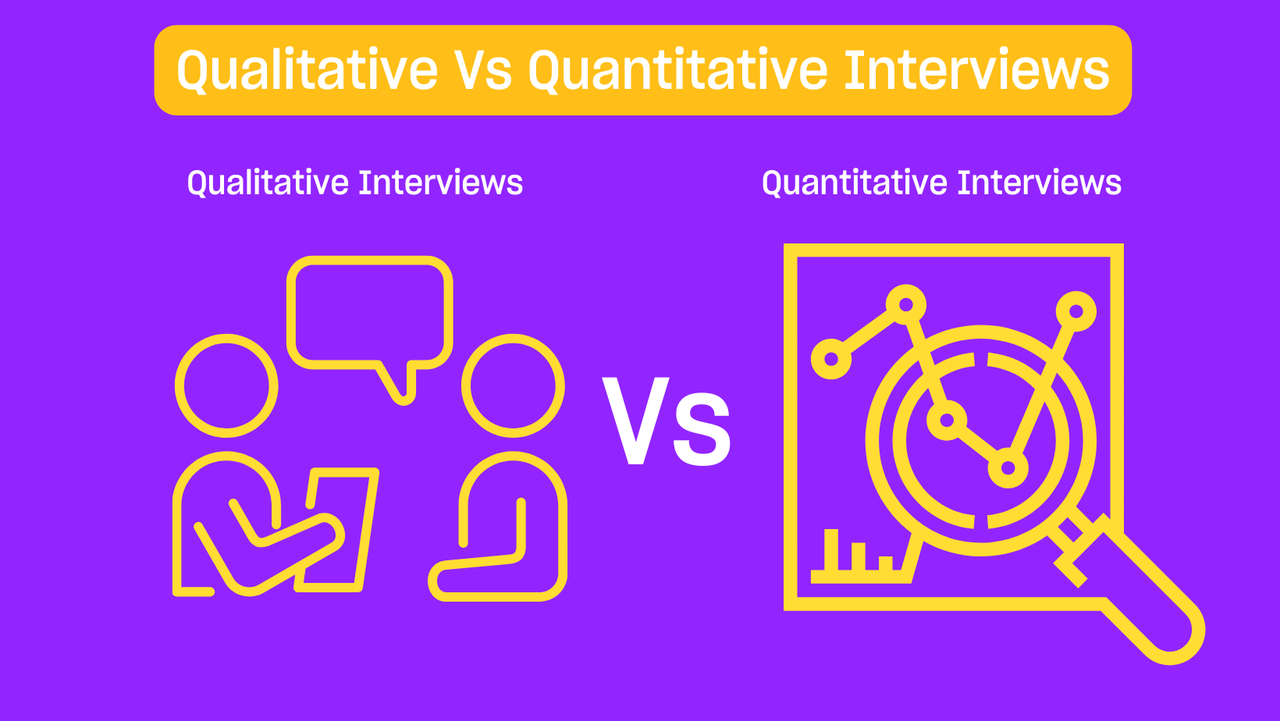
Qualitative and quantitative interviews are different research approaches, each with a unique strategy for collecting and interpreting data. Quantitative interviews seek to measure human behaviour and experiences in a form that can be statistically examined, whereas qualitative interviews concentrate on investigating and comprehending the depth and complexity of human behaviour and experiences.
While both are extensively used in the field of research, it is important to understand where either of the two should be used. Below is a comparative table of both against which you can determine which of the two would work best in your scenario.
This table presents a clear contrast between qualitative and quantitative interviews, highlighting the differences in their technique, strategy, and study conclusions. The choice between both majorly depends on the research question at hand and the nature of the topic being studied.
How to transcribe an interview for qualitative research

For qualitative research, transcription of interviews is a painstaking procedure that needs time and close attention to detail. It requires turning spoken words from your recorded audio or video into text.
In qualitative research, this transcribing procedure is essential to data processing. Here's a step-by-step tutorial on effectively transcribing interviews, along with a few tips to make the process as easy as it can be.
Record clear audio of the interview
Select a peaceful, quiet workstation for your interviews to reduce distractions and improve focus. It is important to have a well-positioned microphone and high-quality headphones if you want to record even the minute details of speech without picking up excessive background noise.
If there are any unpleasant noises in your audio, services like Good Tape can be quite helpful. They are made to carefully pick up on all spoken and nonverbal cues, even in busy settings, and automatically transcribe all your work for you, so you won't miss any important information.
Work around your transcription
Precise transcription is essential for detailed analysis, accurately recording each word and nonverbal cue. This comprehensive approach allows for a deeper understanding of both the verbal as well as non-verbal cues in communication.
Similarly, intelligent verbatim concentrates on streamlining the text by eliminating unnecessary words and sounds to focus on the primary concepts, resulting in a transcript that is more focused and structured. Revised transcriptions enhance the material by improving clarity and fixing grammar, guaranteeing that the final transcript is accurate, comprehensible, and cohesive.
Audio transcription services such as Good Tape make accurate transcription easy with a shorter turnaround time.
Finalise the transcript
For easy navigation and the identification of important points or sensitive parts within the text, transcript formatting consistency is essential. Consistent formatting facilitates reading and improves the transcript's overall usefulness.
A further crucial stage is anonymisation, which anonymises any confidential or private data to comply with legal regulations. This also gives the interviewees peace of mind knowing that the information they provide will not be used illegally. To ensure that the transcript is correct, well-written, and presented professionally, one last review is necessary to spot any spelling, grammatical, or flow errors.
Some useful tips
Manual transcription can take a lot of time, therefore patience is essential. However, if you wish to have accurate transcripts in less time, using services such as Good Tape can cut down on the amount of time required.
It's also very important to make sure that your transcribed documents are safe. Maintaining regular backups is essential to avoiding data loss. Using services that automatically store and back up your transcribed audio might be a sensible choice if you find it difficult to remember to do backups, since they provide efficiency and peace of mind.
Why accurate transcription matters in qualitative research
Precise transcription is essential to qualitative research because it supports the accuracy and essence of the whole research process. It is the first stage of data analysis and has a direct impact on the findings and recommendations of the study. There are several reasons why accurate transcribing is important and advantageous.
Impact on data analysis
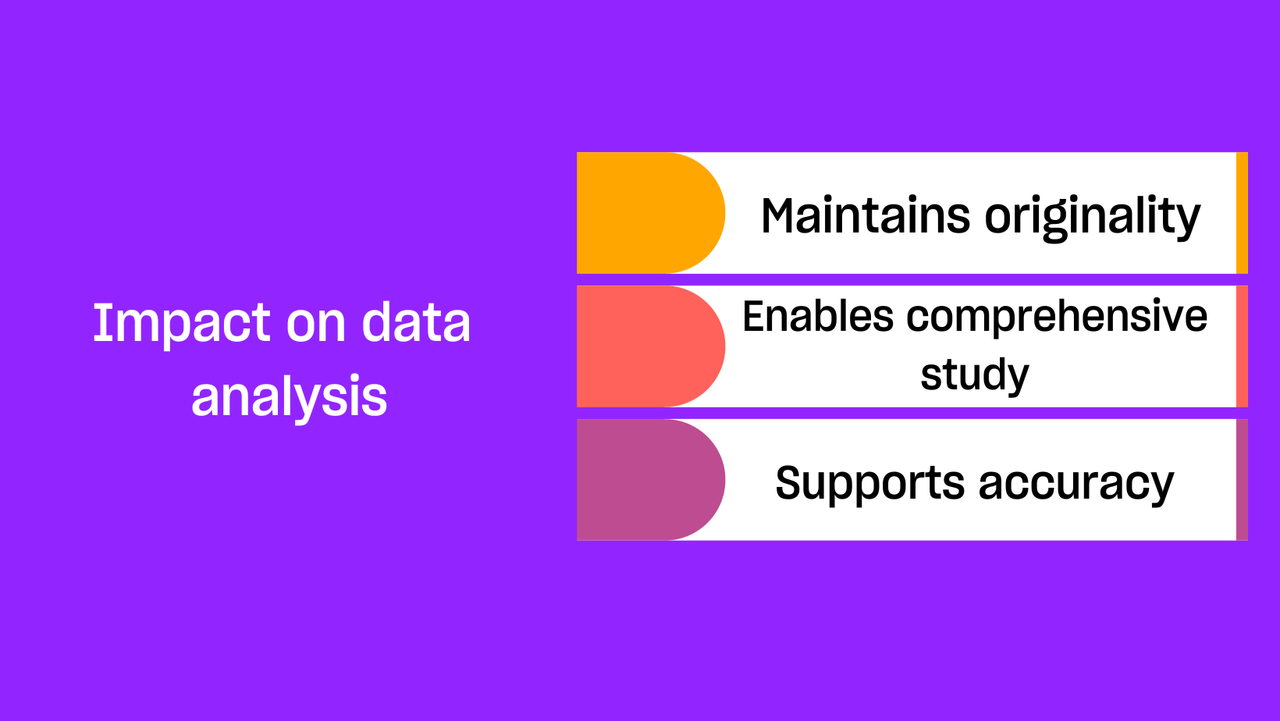
- Maintains originality: Preserving the original context of spoken words is ensured via precise transcription. For accurate interpretation of the data, this is essential.
- Enables comprehensive study: If the transcription has even minute error, it may prevent researchers from doing a thorough study of the interview data, including discourse, theme, and content analysis. Conversation analysis requires a lot of details which is possible through detailed notes of its accurate transcription.
- Supports accuracy: Data analysis in qualitative research is a very crucial step. More valid findings are produced when transcripts are accurate because they give researchers a solid foundation.
Impact on research outcomes
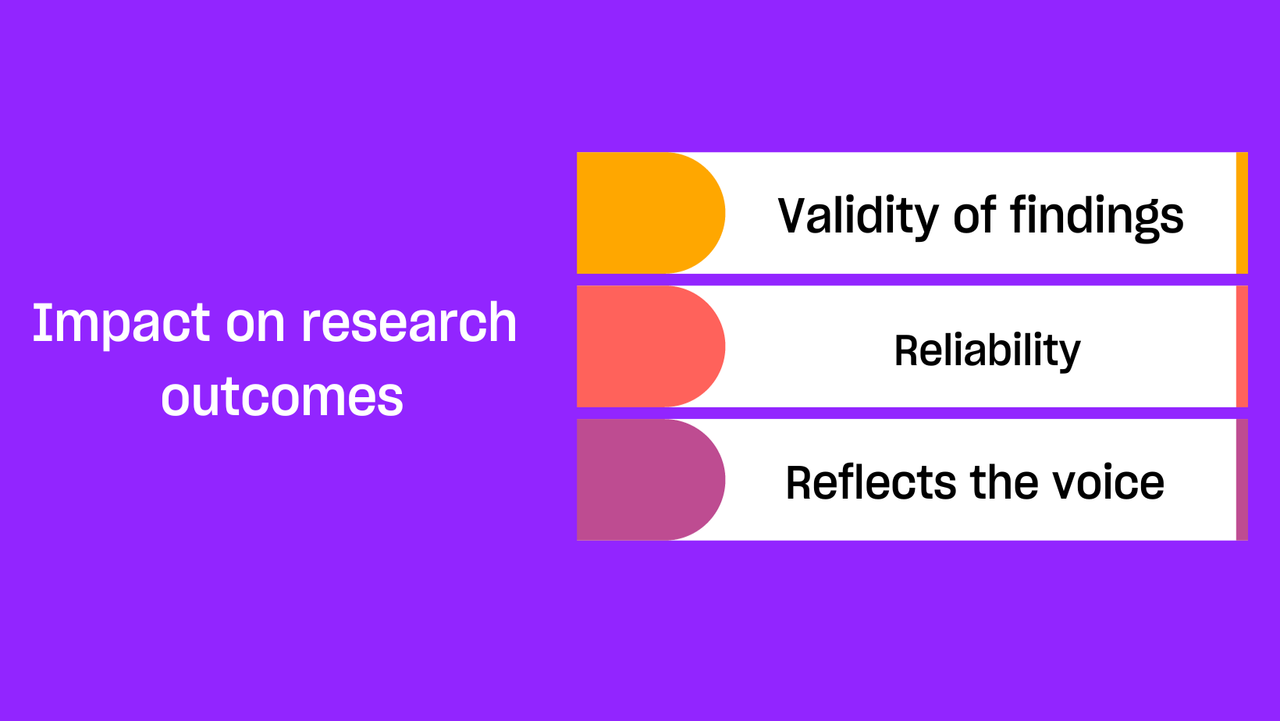
- Validity of findings: The reliability of the study findings is directly impacted by the quality of the transcribing. Inaccurate conclusions may result from word misinterpretation or omission.
- Reliability and reproducibility: A key component of scientific investigation is replication, which is made possible by accurate transcribing, which also increases the research's dependability.
- Reflects the voice of the participant: Accurate transcribing preserves the integrity of the participants' contributions by correctly capturing their voices.
Benefits of accurate transcription
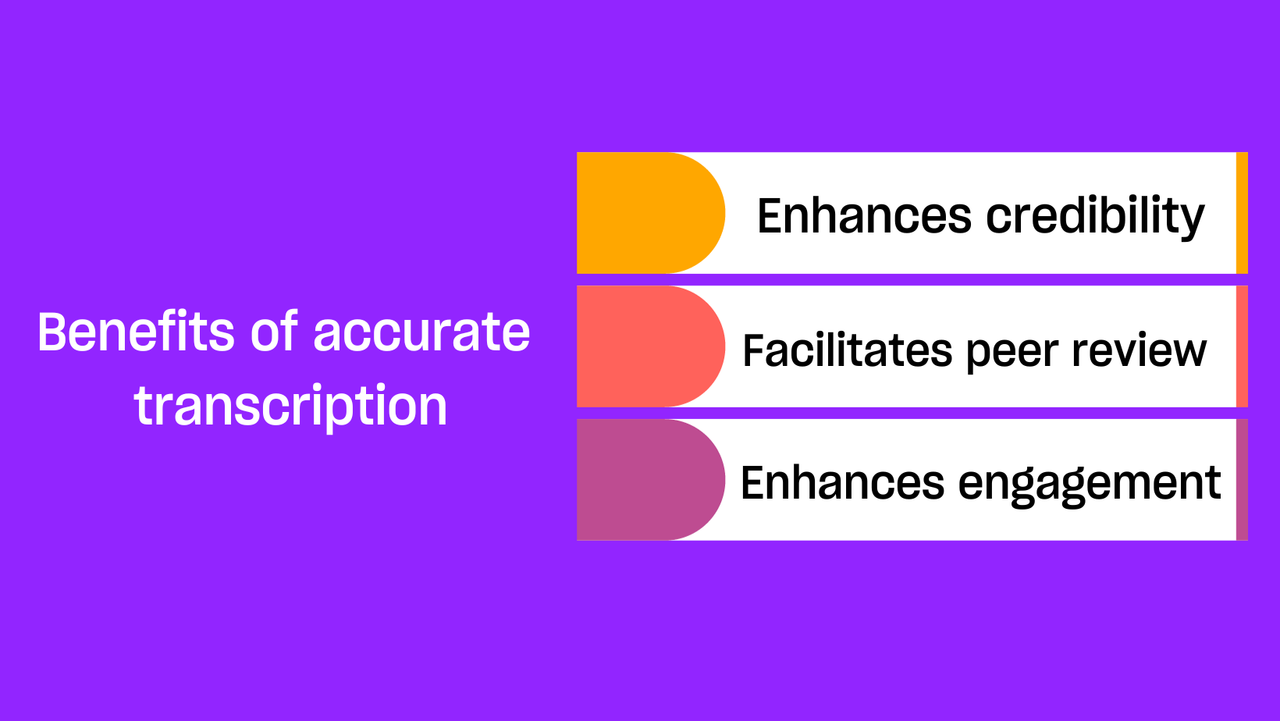
- Enhances credibility: Precisely recorded information strengthens the credibility of the study among other researchers and readers
- Facilitates peer review and cooperation: Because other researchers can comprehend and analyse the data with clarity, it makes effective peer review and cooperation possible.
- Enhances engagement with data: When data is precisely translated, researchers may interact with it at a deeper level, which results in more perceptive analysis and interpretation.
Accurate transcription plays a crucial role in maintaining the validity, reliability, and integrity of the research findings. It improves the quality and depth of data analysis, guaranteeing that the conclusions are solid, reliable, and accurate representations of the experiences and viewpoints of the participants.
Discover Good Tape’s interview transcription service
We’ve understood in depth how to transcribe interviews for qualitative research, let’s go over how you can do so accurately and quickly without having to put in much effort. Good Tape has a relatively simpler user interface which you can navigate through without any manual or instructions. Here’s what you can expect when going through the process of transcribing your audios.
- Upload your file: The first step in the process is to upload the file you need to transcribe. Make sure the file is complete and has all the information you require

- Select the language: Good Tape has a number of options when it comes to choosing the language of transcription. Select the one you want, although you can also choose the “auto-detect” option for the system to automatically identify the language in the audio.
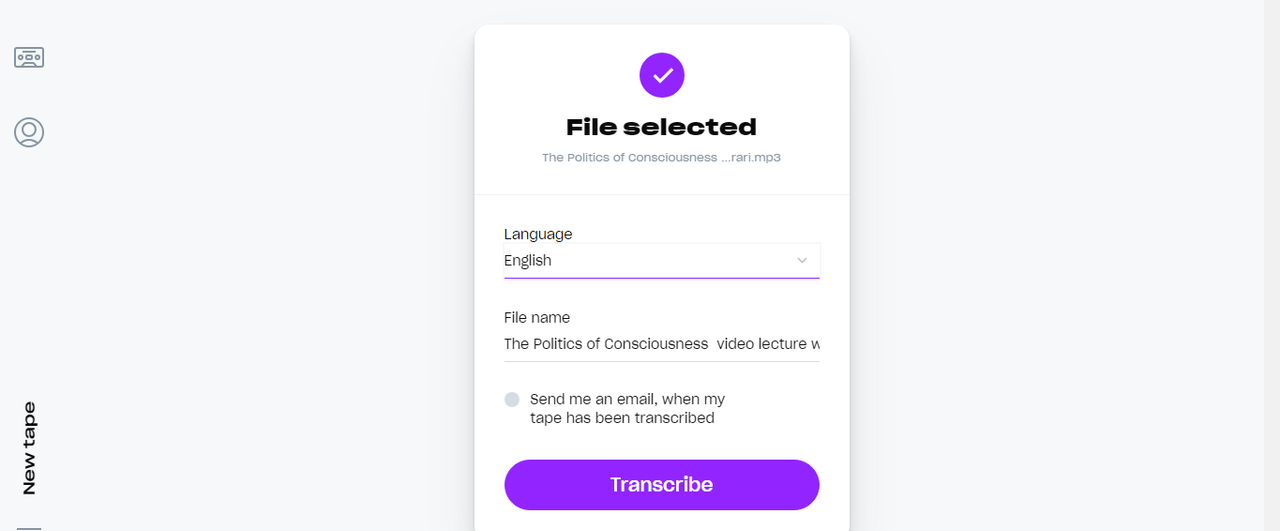
- Transcribe the text: Once the file is uploaded and the language is chosen, proceed further by clicking the “transcribe” button. Your audio transcription process starts here.

- To wait or not to wait: If you’re a casual plan user, you will have to wait for some time for your transcription to be completed due to excessive load by the users. However, if you’re a professional or a team user, you get your results ASAP! The wait time depends on the plan you’re subscribed to .
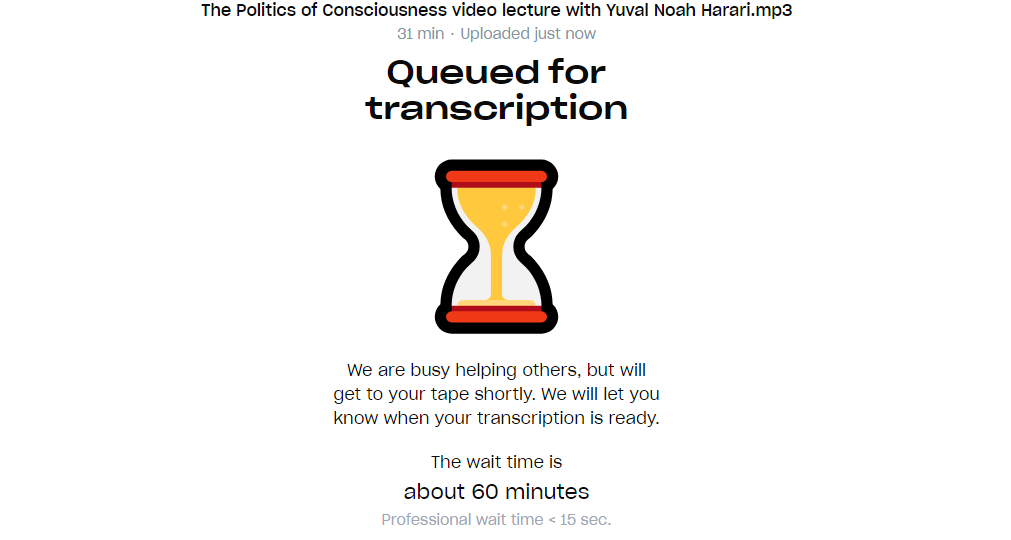
- Get notified: You will receive a notification once your transcribed document is ready. An e-mail will be sent to your inbox containing the link to access and download the document.
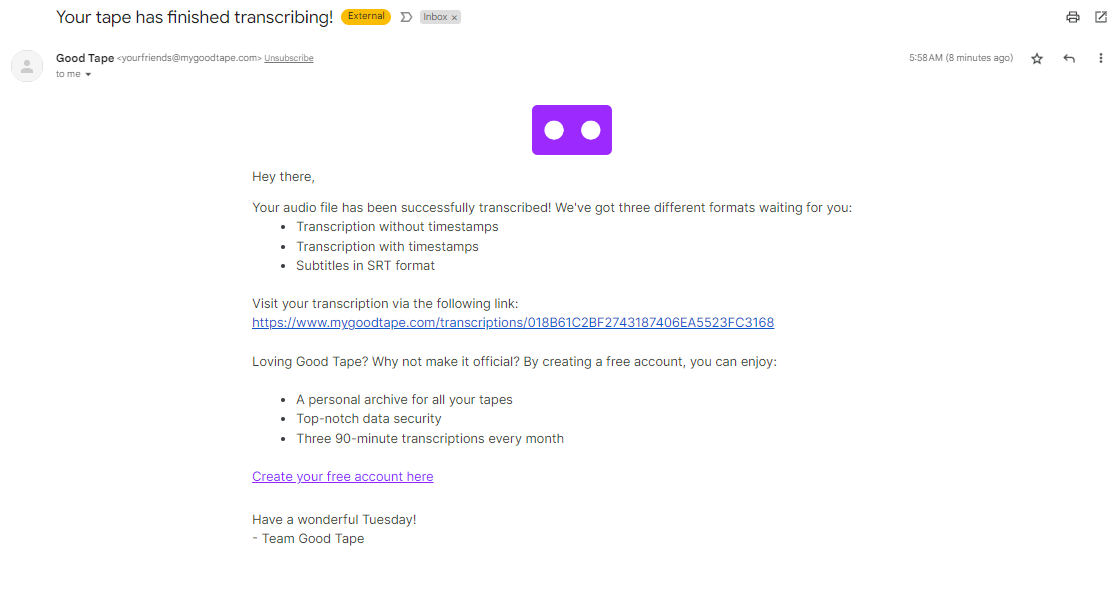
Looking for a good transcribing interviews qualitative research service? Try out Good Tape’s audio-to-text transcription service today and increase your work productivity. Their AI incorporated technology makes sure that every verbal and non-verbal cue is recorded, giving your qualitative data a deeper level of understanding.
More articles

What is verbatim transcription?


The essential transcription services for qualitative research

Board meeting transcription

The power of meeting recording and note-taking
We believe everyone should have access to top-quality automatic trancriptions.
That's why Good Tape is completely free to use . No credit card required.
Why is it free?
How to Analyze Interview Transcripts in Qualitative Research
Rev › Blog › Transcription Blog › How to Analyze Interview Transcripts in Qualitative Research
Studies take time, accuracy, and a drive to provide excellent information, and qualitative research is a critical part of any successful study. You may be wondering how qualitative data adds to a paper or report, given that it’s not the hard “science” we often see highlighted the most often.
How Do You Analyze Qualitative Interviews?
There are two main approaches to qualitative analysis: inductive and deductive . What’s more, there are two types of inductive qualitative analysis to choose from. These are called thematic content analysis and narrative analysis, both of which call for an unstructured approach to research.
Inductive Methods of Analyzing Interview Transcripts
A thematic content analysis begins with weeding out biases and establishing your overarching impressions of the data. Rather than approaching your data with a predetermined framework, identify common themes as you search the materials organically. Your goal is to find common patterns across the data set.
A narrative analysis involves making sense of your interview respondents’ individual stories. Use this type of qualitative data analysis to highlight important aspects of their stories that will best resonate with your readers. And, highlight critical points you have found in other areas of your research.
Deductive Approach to Qualitative Analysis
Deductive analysis , on the other hand, requires a structured or predetermined approach. In this case, the researcher will build categories in advance of their analysis. Then, they’ll map connections in the data to those specific categories.
Each of these qualitative analysis methods lends its benefits to the research effort. Inductive analyses will produce more nuanced findings. Meanwhile, deductive analyses allow the researcher to point to key themes essential to their research.
Successful qualitative research hinges on the accuracy of your data. This can be harder to achieve than with quantitative research. It’s easy to lose important facts and meaning as you transition qualitative data from the source to your published content. This makes transcription a vital tool in maintaining integrity and relaying information in an unbiased way that’s useful for readers and adds appropriate context to the journal or study.
How to Transcribe a Qualitative Interview
Accurate transcription begins early in the interview process, even before you start interviewing. Here are the steps to transcribing a qualitative interview.
1. Collect Feedback for Qualitative Research
There are dozens of ways to gather qualitative data. Recording and accurately transcribing interviews is among the best methods to avoid inaccuracies and data loss, and researchers should consider this approach over simply taking notes firsthand.
Make sure you have a reliable way to record, whether the interview takes place in person, over the phone, or as part of a video call. Depending on the interview method, you may record a video or an audio-only format. Here are some tips depending on where the interview takes place:
- These apps can also be used for over-the-phone interviews.
- For video interviews , we recommend taking advantage of one of our transcription integrations , such as Zoom. Rev also has an API available for those who want to streamline their workflow even further by integrating Rev directly into their processes and platforms.
2. Organize Your Research Recordings
You should ensure that your audio or video files are easy to save, compile, and share. To do this, be sure to adopt easy-to-remember naming conventions as well to ensure they stay organized. An example of a naming convention that is simple to remember and recreate includes “Date.LastNameofSource.Topic”.
3. Transcribe All the Interviews and Focus Group Recordings
The next critical step is transcription. Done manually, this is a long and tedious process that can add hours, days, or even months to your report-writing process. There are dozens of pitfalls when performing transcriptions manually as well, as it can be hard to pick up words spoken in a heavy dialect or quiet tone. You also want to avoid having to transcribe all the “umms” and “ems” that occur when a source is speaking naturally.
Rev provides a variety of transcription services that take the tedium and guesswork out of the research process. You can choose to edit out all of the “umms,” while ensuring that heavy accents or muffled voices are picked up by the recording service.
You can order transcripts from Rev with both audio and video recordings. Once you’ve received your professional transcripts from Rev, you can begin your qualitative analysis.
The 6 Steps of Qualitative Interview Data Analysis
Among qualitative interview data analysis methods, thematic content analysis is perhaps the most common and effective method. It can also be one of the most trustworthy , increasing the traceability and verification of an analysis when done correctly. The following are the six main steps of a successful thematic analysis of your transcripts.
1. Read the Transcripts
By now, you will have accessed your transcript files as digital files in the cloud or have downloaded them to your computer for offline viewing. Start by browsing through your transcripts and making notes of your first impressions. You will be able to identify common themes. This will help you with your final summation of the data.
Next, read through each transcript carefully. Evidence of themes will become stronger, helping you to hone in on important insights.
You must identify bias during this step as well. Biases can appear in the data, among the interviewees, and even within your objectives and methodologies. According to SAGE Publishing , researchers should “acknowledge preconceived notions and actively work to neutralize them” at this early step.
2. Annotate the Transcripts
Annotation is the process of labeling relevant words, phrases, sentences, or sections with codes. These codes help identify important qualitative data types and patterns. Labels can be about actions, activities, concepts, differences, opinions, processes, or whatever you think is relevant. Annotations will help you organize your data for dissemination .
Be generous with your annotations—don’t hold back. You will have an opportunity to eliminate or consolidate them later. It’s best to do more here, so you don’t have to come back to find more opportunities later.
3. Conceptualize the Data
Conceptualizing qualitative data is the process of aligning data with critical themes you will use in your published content. You will have identified many of these themes during your initial review of the transcripts.
To conceptualize, create categories and subcategories by grouping the codes you created during annotation. You may eliminate or combine certain codes rather than using all the codes you created. Keep only the codes you deem relevant to your analysis.
4. Segment the Data
Segmentation is the process of positioning and connecting your categories . This allows you to establish the bulk of your data cohesively. Start by labeling your categories and then describe the connections between them.
You can use these descriptions to improve your final published content.
- Create a spreadsheet to easily compile your data.
- Then, use the columns to structure important variables of your data analysis using codes as tools for reference.
- Create a separate tab for the front of the document that contains a coding table. This glossary contains important codes used in the segmentation process. This will help you and others quickly identify what the codes are referring to.
5. Analyze the Segments
You’re now ready to take a deep dive into your data segments . Start by determining if there is a hierarchy among your categories. Determine if one is more important than the other, or draw a figure to summarize the results. At this stage, you may also want to align qualitative data with any quantitative data you collected.
6. Write the Results
Your analysis of the content is complete—you’re ready to transition your findings into the real body of your content. Use your insights to build and verify theories, answer key questions in your field, and back aims and objectives. Describe your categories and how they are connected using a neutral, objective voice.
Although you will pull heavily from your own research, be sure to publish content in the context of your field. Interpret your results in light of relevant studies, theories, and concepts related to your study.
Why Use Interviews for Qualitative Data
Unlike quantitative data, which is certainly important, a qualitative analysis adds color to academic and business reports. It offers perspective and can make a report more readable, add context, and inspire thoughtful discussion beyond the report.
As we’ve observed, transcribing qualitative interviews is crucial to getting less measurable data from direct sources. They allow researchers to provide relatable stories and perspectives and even quote important contributors directly. Lots of qualitative data from interviews enables authors to avoid embellishment and maintain the integrity of their content as well.
So, how do you conduct interview data analysis on qualitative data to pull key insights and strengthen your reports? Transcribing interviews is one of the most useful tools available for this task.
As a researcher, you need to make the most of recorded interviews . Interview transcripts allow you to use the best qualitative analysis methods. Plus, you can focus only on tasks that add value to your research effort.
Transcription is Essential to Qualitative Research Analysis
Qualitative data is often elusive to researchers. Transcripts allow you to capture original, nuanced responses from your respondents. You get their response naturally using their own words—not a summarized version in your notes.
You can also go back to the original transcript at any time to see what was said as you gain new context. The editable digital transcript files are incredibly easy to work with, saving you time and giving you speaker tags, time marks, and other tools to ensure you can find what you need within a transcript quickly.
When creating a report, accuracy matters, but efficiency matters, as well. Rev offers a seamless way of doing the transcription for you, saving you time and allowing you to focus on high-quality work instead. Consider Rev as your transcription service provider for qualitative research analysis — try Rev’s AI or Human Transcription services today.
Everybody’s Favorite Speech-to-Text Blog
We combine AI and a huge community of freelancers to make speech-to-text greatness every day. Wanna hear more about it?

How to Transcribe Interviews for Qualitative Research
Saving time and effort with Notta, starting from today!
Collecting numerical data is as easy as clicking copy and paste. But what about the unique feedback, comments, and descriptions of qualitative data? Not so much. Once you’ve figured out your research objectives and conducted your interviews, everything else feels intimidating. How do you transcribe entire interviews if every participant talks about something different? How do you even measure answers in natural language with unique viewpoints?
I feel you. When I managed customer support for an online company a few years ago, a lot of our valuable feedback didn’t come from scores out of 10 on product surveys, but rather from customer emails, reviews, and social media comments telling us what they loved and where we could do better. I think that’s why transcribing interviews for qualitative research like this is so important. It’s the first step in organizing all kinds of information into groups and themes you can actually use.
Keep reading because I’ll explain more about how to transcribe an interview (and why you should), plus using transcription software for qualitative research to speed things up.
What is Qualitative Research?
Qualitative research is when you ask open questions that prompt people for descriptive answers. It encourages feedback and observations that you can’t measure with numbers. If quantitative research finds out the facts from numbers , qualitative research is the reason why people make specific choices or behave a certain way .
What is an Interview?
An interview is a great qualitative feedback method whereby you ask a series of open-ended questions to an interviewee to gain answers, feedback, and opinions in their own words. You can conduct interviews in person, over the phone, or on video, solo or in groups.
How to Prepare an Interview for Qualitative Research
1. Decide Important Information for Your Interview
Start with your research objectives and create questions based on these - what do you want to learn?
How will you structure your interview? For structured interviews, prepare a list of questions to ask. For unstructured interviews, list topics you want to talk about.
Use open-ended questions to help the interviewee express their thoughts in their own words.
Ask your team to review and approve the interview questions before you begin so you can tweak them if needed.
2. What You Need from Your Research Interview Transcription
How will you extract answers and comments from your transcripts? Coding answers for specific questions and connecting themes can help categorize the data.
Will you read through the entire transcript or condense the conversation into bullet points? You can format your transcript in three ways:
Full Verbatim : The conversation in a raw, unedited state including slang and false starts
Intelligent Verbatim : A cleaned-up version of the full transcript, written in a grammatically correct way without false starts or stuttering
Detailed notes : Summarizing the conversation into scannable notes that cover the main points of conversation
3. Have Your Tools Ready
Choose a good quality microphone and noise-canceling headset that provides clear audio for easy communication.
What device will you use to conduct the interview and write the transcript? Have your PC, Mac, or tablet up to date with software installed.
Settle on the transcription software you’ll use. If you’re typing the transcript manually, have your preferred text editor installed. For automatic transcription, set up your Notta account and log in.
How to Transcribe an Interview for Qualitative Research
Manually transcribe your interview.
Listen to the recorded interview all the way through to familiarize yourself with the content of the conversation.
Open your favorite text editor such as Microsoft Word or Notepad and begin writing the speech while you listen to the recording. Don’t worry about getting it perfect the first time, just write as much as possible.
Go through the transcript again while listening to the audio, this time adding in timestamps in [HH:MM:SS] format and speaker tags every time the interviewer and interviewee speak, with a tag such as [Rachel] or [Interviewer]. If the interviewee wishes to remain anonymous, you can use a general tag such as [Interviewee].
Save your document to your device and share with your research team. Repeat these steps for every interview.
Automatically Transcribe Qualitative Interviews with Notta
Upload an existing recording to notta.
Log into Notta and go to your Dashboard .
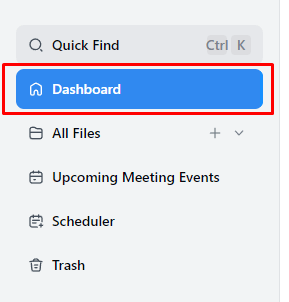
Click ‘ Import files ’. You can drag and drop your audio or video file or paste a Google Drive, Dropbox, or YouTube link in the ‘ Import from link ’ field.
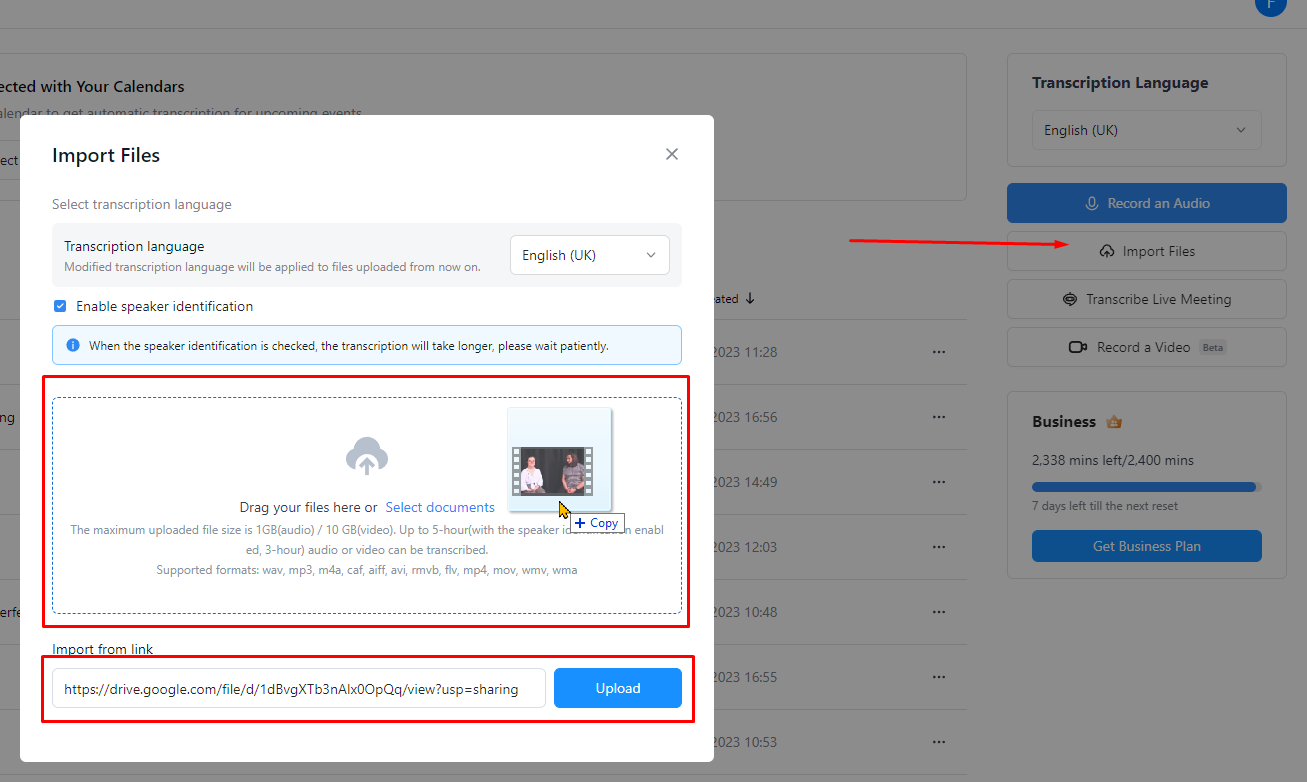
Record a Live Meeting or Live Audio with Notta
Click ‘ Transcribe live meeting ’ and paste your meeting link from Zoom, Google Meet, Microsoft Teams, or Webex, if you’re conducting your meeting virtually. This invites Notta Bot to record and transcribe your conversation.
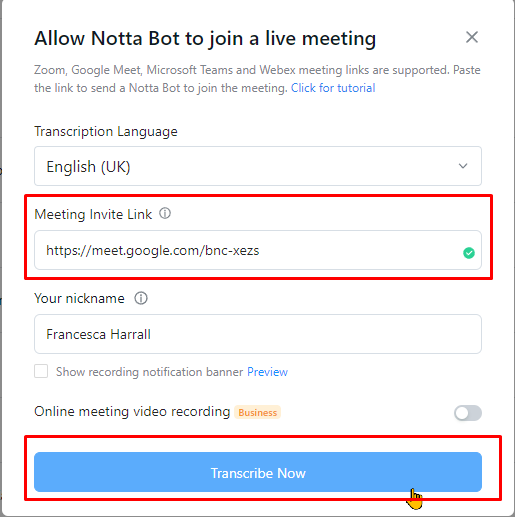
Click ‘ Record an Audio ’ if your interview is in person. This starts recording using your microphone and transcribes in real time.
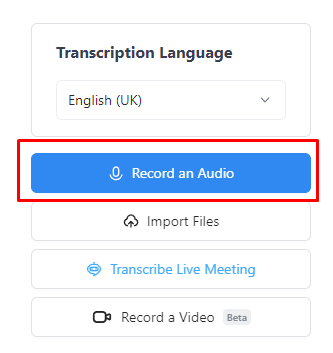
Edit, Export, and Share Your Transcript
Click on the interview transcript under ‘ Recent Recordings ’ on your Notta dashboard.

Read through the full transcript. You can adjust the blocks of text by clicking your cursor and pressing ‘ Enter ’ or ‘ Delete ’ to join or separate transcript text.
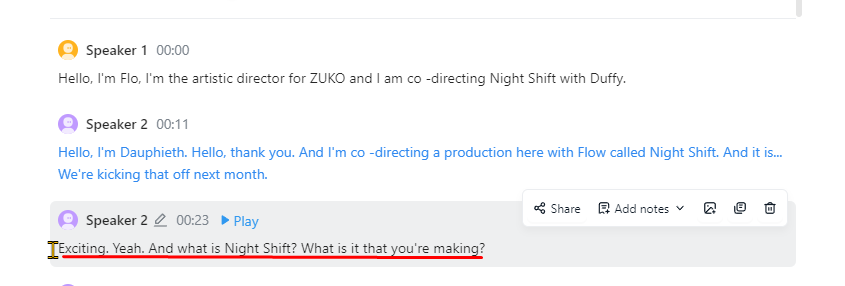
Click a speaker’s name to change it. You can type their name and then decide whether you want to adjust it for this block of text only, or for the entire transcript. Remember, if an interviewee wants to remain anonymous, you can type a generic tag like ‘Interviewee’.
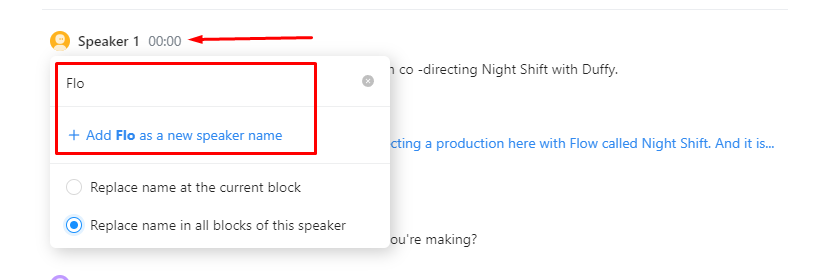
Correct transcription errors by typing directly into the transcript text. Click the highlighted words or phrases in blue and the audio playback will jump to this point.
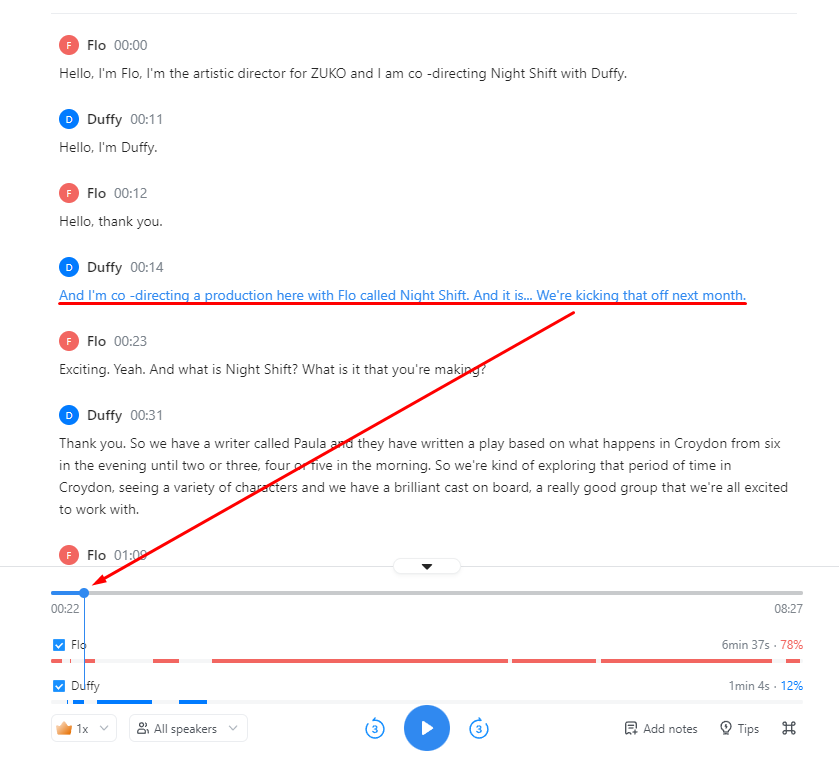
Add written notes and images to specific points in your transcript using the floating toolbar. This is helpful if you want to add observations you made during the interview.

Click the ‘ Download ’ icon at the top of your transcript page and export in a variety of formats. Notta exports in MP3, TXT, SRT, PDF, DOCX, and XLSX. You can toggle timestamps, speakers, and more.
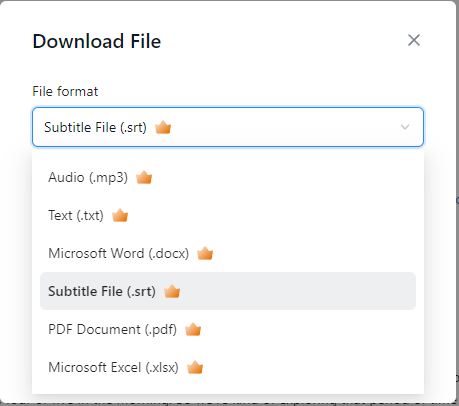
Share the transcript with people in your team by clicking the ‘ Share ’ button, then managing group and team permissions with the drop-down menus. Create a shareable link by toggling ‘ Share ’ on and copy the link provided.
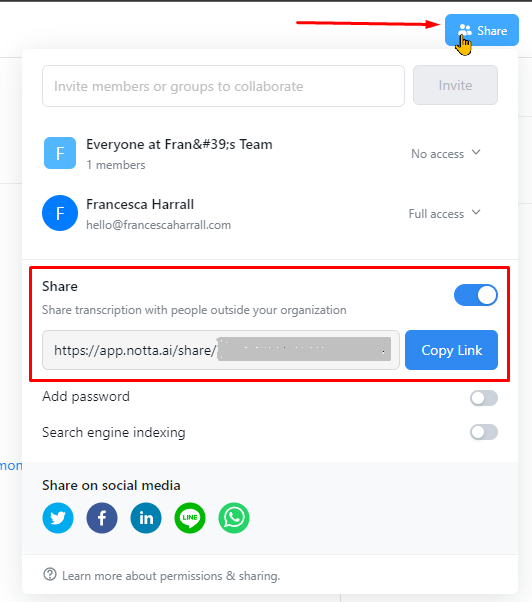
How to Analyze the Interview Qualitative Data
At first glance, you might feel daunted by the prospect of arranging your qualitative data. After all, numerical and factual data is easy to organize. But what about unique answers, observations, and feedback? Don’t worry—here are some simple steps you can follow to analyze your findings without pulling your hair out.
Organize the Information You Collected at Interview
To study your interviews effectively, use the same method of collection for every interview. This means transcribing each interview in the same way and asking the same or similar questions to each participant. This way, you can stick to the same process when analyzing what data you’ve collected.
Summarize Insights Using Your Transcript
Reading through full transcripts takes a lot of time, so you may find it easier to condense the information into a summary. Use Notta AI to create a summary in a few moments.
Click the ‘ Magic wand ’ icon in your Notta transcript and then click ‘ Generate ’. Notta AI uses machine learning to create an AI summary with three useful parts:
AI Summary: A condensed version of your full transcript, highlighting the basic points
Chapters: A list of key moments and themes during the conversation
Action items: A list of next steps to take, according to the conversation
Explore the Data
Creating a coding system helps you categorize the data and make it easier to understand. Codes can vary and come in a variety of formats but here are some examples:
Descriptive codes : Providing context for the data such as ‘interview setting in coffee shop’.
In-Vivo codes : A verbatim phrase the interviewee used to describe a product or service such as ‘I couldn’t live without it’.
Themed codes : Describing an overarching theme or pattern relating to the interview questions such as ‘accessibility issues’.
Process codes : Identifies what stage of the process the interviewee is currently at in relation to your product or service, such as ‘canceled subscription’ or ‘I’ve heard of your product recently’.
It’s vital that everyone involved in research sticks to these pre-agreed codes to organize data efficiently. It’s okay if you need to revise your methods as you go, but keep everyone informed so there’s no confusion.
Present Your Research
To make your research findings easier to interpret, you can organize them in several ways. Here are some common methods to share your data:
Spreadsheets : arrange your data into a table
Graphs : Displays themes and patterns using their codes in visual graphs
Word clouds : Using In-Vivo codes, displays the most commonly used language by participants
Are There Any Other Qualitative Research Methods?
Interviews aren’t the only way to collect useful qualitative data. If you’re pressed for time or need a deeper understanding of a culture or group, you can try other options.
Observations : Observing peoples’ behaviors in their natural setting without directly interacting with them. Take detailed field notes to describe what you can see, hear, and encounter in terms of interactions.
Focus groups : Taking a small group of people and asking questions. Their answers and interactions with each other can provide verbal and non-verbal insights.
Ethnography : Immersing yourself in a culture or group of people to understand their behaviors, rituals, and perceptions. This is similar to observations but might require deeper and longer-term fieldwork.
Narrative analysis : Studying personal stories, biographies, and autobiographical data to understand the perceptions and meanings people give to certain experiences.
Surveys : Create a series of open-ended questions in a questionnaire to distribute to people, to get unique feedback in their own words.
Secondary research : Gathering different, pre-existing sources of feedback as qualitative data. This includes emails, texts, images, videos, audio recordings, documents, policies, and diaries.
Frequently Asked Questions about Transcription in Qualitative Research
What is a good example of qualitative data.
Qualitative data is valuable when it provides insights into a person’s reasoning behind certain behaviors and lived experiences. Some examples of good qualitative data could include:
Documents like contracts, notes, and emails that contain descriptive, non-numerical data
Social media post and forum comments expressing authentic discussions and opinions
Audio or video recordings of natural conversations
The best qualitative data provides real, descriptive feedback in a person’s natural language. It should express feelings, emotions, attitudes, and perceptions.
Is Qualitative Research Subjective?
Yes, qualitative research is subjective because it’s relative to that individual’s culture, experience, and perceptions. It’s based on opinions and thoughts. Quantitative data is objective because it deals with numerical facts. Both have a place in research, but the subjective nature of qualitative research provides reasoning behind behaviors and decisions.
Why Should You Choose Qualitative Research?
There are many reasons why qualitative research is valuable:
It’s unbiased, as participants can provide thoughts and opinions in their own words.
You can uncover new theories and hypotheses that you may not have known about previously. Collecting qualitative data is often unstructured, allowing people to express new ideas and themes
Gain a deeper understanding of trends. Participants using their own language allows you to find common patterns and insights on a particular issue.
You can discuss sensitive topics. Participants can broach subjects in their own words and share as much as they feel comfortable with.
What is the Difference Between Qualitative and Quantitative Data?
Quantitative data is fixed, numerical feedback. Examples can include annual income, number of people in a household, times a person has bought a specific item, and so on. Qualitative data provides non-numerical, descriptive feedback in natural language. Examples might look like thoughts about a brand’s new color scheme or favorite part of visiting a recent conference.
How Do I Record an Interview?
Here are some basic steps you can follow to prepare for recording an interview as part of your qualitative research:
Write out a list of open-ended questions or a list of topics you want to cover.
Check that the device you’re recording on is charged.
Plug in your microphone and headphones and test them.
Conduct your interview in a quiet environment.
Use the meeting software’s built-in recorder such as Zoom, or a meeting recorder such as Notta.
When the interview starts, set your interviewee at ease by asking some icebreaker questions about their day, their plans, and themselves to get to know each other better and build rapport.
Move onto your interview questions, leaving plenty of time for the interviewee to gather their thoughts and answer in their own words.
Listen and follow up to ask for clarification if needed.
Thank them for their time and let them know what the next steps are.
Check the recorded audio or video file to ensure it came out clearly, ready for transcription.
See? Transcribing an interview for qualitative research doesn’t have to be stressful or time-consuming when you have a plan! My biggest piece of advice here is to understand the goal of the interviews you’re conducting . Interviews with vague questions and no direction in relation to your research objective aren’t likely to garner you valuable information you can actually use. Once you know what insights you’re aiming to uncover, it makes the conversation feel more productive and your research interview transcription will be far easier to use when collecting the data.
Chrome Extension
Help Center
vs Otter.ai
vs Fireflies.ai
vs Happy Scribe
vs Sonix.ai
Integrations
Microsoft Teams
Google Meet
Google Drive
Audio to Text Converter
Video to Text Converter
Online Video Converter
Online Audio Converter
Online Vocal Remover
YouTube Video Summarizer

Transcript Example (with Microsoft Word and PDF Templates)
This resource includes a transcript example from an interview, formatted in several different ways:
- Clean verbatim style
- True verbatim style
- Timestamps at regular intervals
- Timestamps at speaker or paragraph intervals
I made these .docx and PDF example transcripts for university students, educators, non-profits, journalists, podcasters, filmmakers, and transcriptionists.
Quick tip: If you’re not using it already, you can install free transcription software like Express Scribe to help you manually transcribe interviews much faster. The software lets you control audio playback using hotkeys so you don’t have to keep starting and stopping audio with your mouse.
If you want to go really fast, I also recommend getting a transcription foot pedal (I use the Infinity pedal ). Together, these two tools will save you hours upon hours of transcription time. (Or learn more about our interview transcription services .)
If you’re a professional content creator, you may also be interested in our posts about AI-powered tools for scaling up your audio and video production workflow:
- Best AI Video Upscaling Software
- Best AI Video Generators
- Best AI Video Editors
Now, on to the transcript examples!
This post may contain affiliate links. See my disclosure for more info.
Interview transcription format sample for Microsoft Word
Download this transcription format template for Microsoft Word for use with interviews and qualitative research projects:
Interview Transcription Template – Word (.docx)
Clean verbatim vs. true verbatim transcript examples
There are two main styles of transcription used in interviews and qualitative research:
- Clean verbatim (also called intelligent verbatim or non-verbatim).
- True verbatim (also called strict verbatim, or simply “verbatim”).
A clean verbatim transcript is a lightly edited version of the original audio. Typically, the following elements are removed:
- Filler speech, including “um,” “uh,” etc.
- Most non-speech sounds, including coughing and throat clearing
- False starts
A true verbatim transcript, on the other hand, attempts to capture every utterance of the speakers. These include stutters, meaningless filler speech, and false starts. Verbatim style may also include non-speech and background sounds, such as coughing and sneezing or a door closing.
While each transcription style is useful under certain circumstances, clean verbatim is used most often because the transcripts cost less and are easier to read.
However, true verbatim may be desirable for certain qualitative and market research projects and legal investigations, where it’s necessary to study not only what was said, but also the manner in which something was said.
Below, I’ve included examples of an interview transcribed in both verbatim and clean verbatim fashion.
Example transcript in true verbatim style
Here’s a sample interview transcript that demonstrates the true verbatim style:
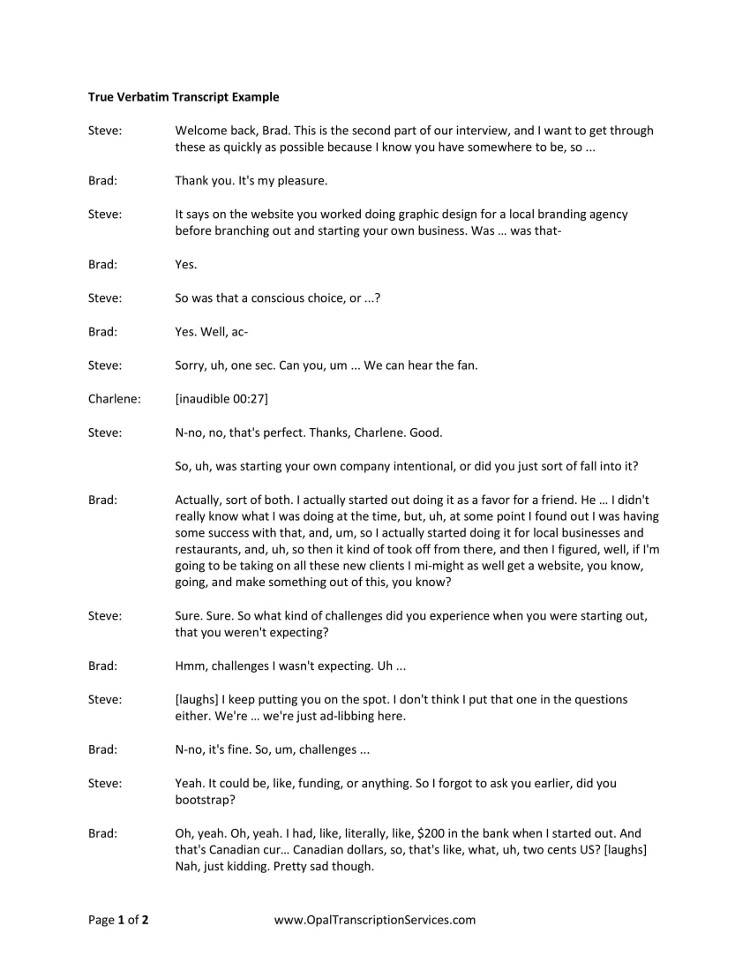
Download the PDF version here: Interview Transcript Example – True Verbatim (PDF)
Example transcript in clean verbatim style
And here’s the same conversation from above, transcribed in clean verbatim:
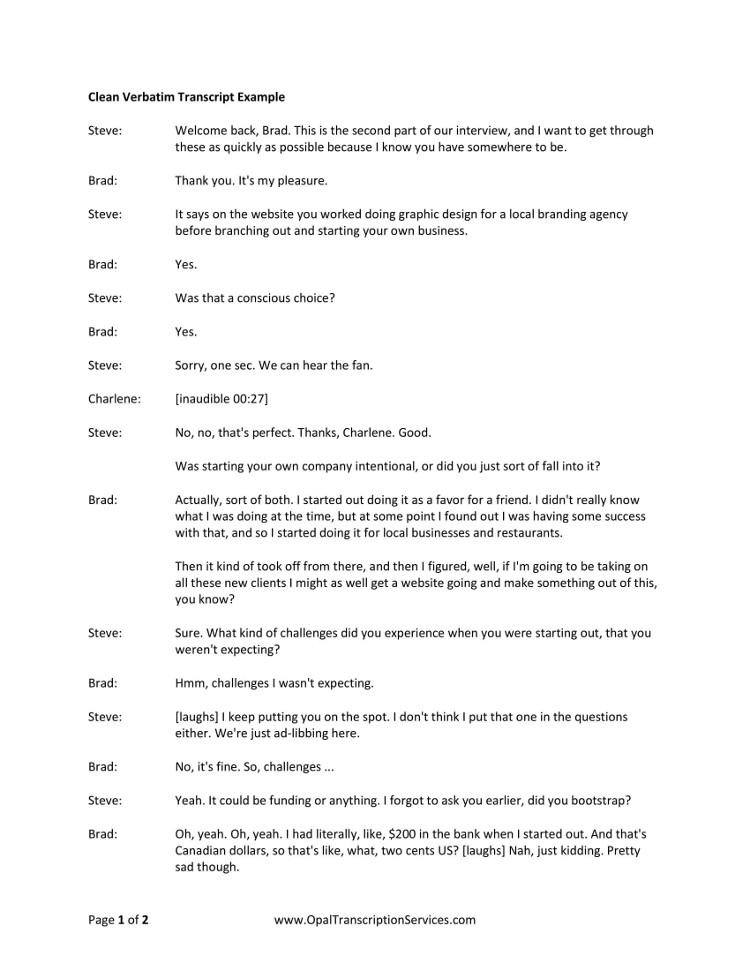
Download the PDF version here: Interview Transcript Example – Clean Verbatim (PDF)
We made the following changes to the second (clean verbatim) transcript:
- We edited out stutters, partial words, and short incomplete sentences.
- We removed meaningless instances of words like “so” at the start of sentences, and “like” when used as filler speech. (However, we left in the word “like” where removing it would have made the meaning literal when it wasn’t intended to be – i.e., when Brad refers to his “like, two” Facebook friends.)
- We chose to leave in the laughter, as it helps capture the overall tone of the interview and the banter occurring between the speakers. We also left in nonsense exclamations like “Uh … phew,” because it helps set the context for what follows. However, we removed other non-speech sounds like coughing and throat clearing that do not contribute anything useful to the content.
- In this particular example, we opted to remove repetitive instances of the word “actually” spoken by Brad, the interviewee. Normally we leave longer words in, but in this case we felt it was a speaker idiosyncrasy that distracted from the content of the interview.
Clean verbatim style is not an exact science, and sometimes there may be overlap between non-verbatim and verbatim styles in a transcript. All in all, the changes we made here make for a cleaner, less distracting, and more valuable interview – without detracting anything meaningful from the original.
Sample transcript with timestamps at regular intervals
Some projects require timestamps to be placed at regular intervals in the transcript so the audio can be easily referenced later.
Below is an example of an interview transcript with timestamps:
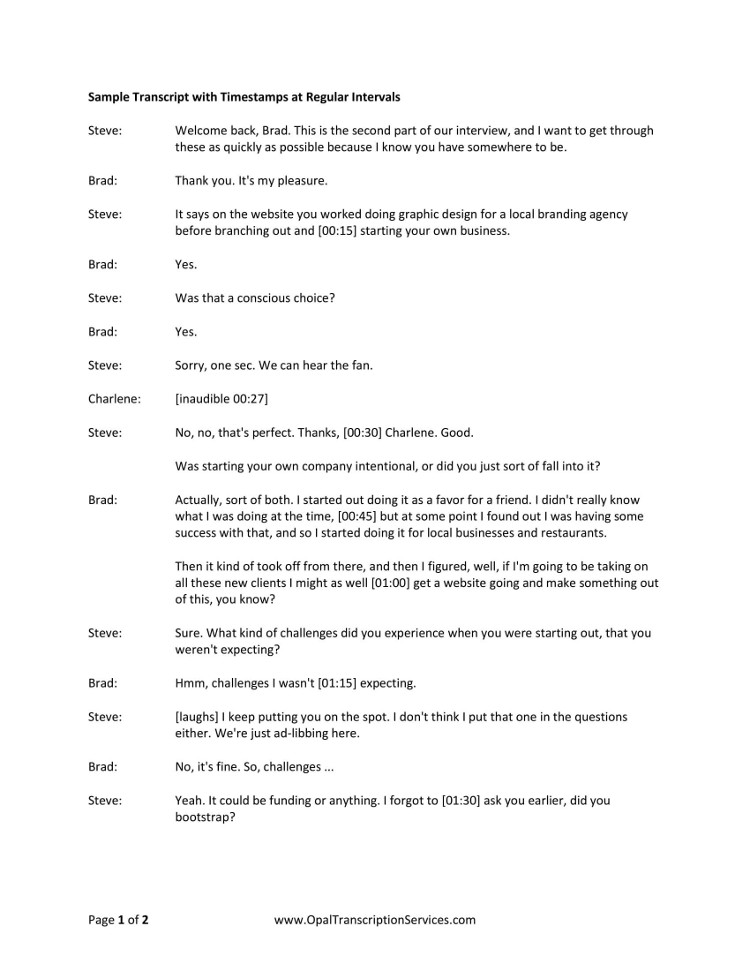
Download the PDF version here: Interview Transcript Example – Timestamps at Regular Intervals (PDF)
Sample transcript with timestamps at speaker intervals
Another way to timestamp a document is to place the timecode markup at speaker or paragraph intervals, like in the following interview transcript sample:
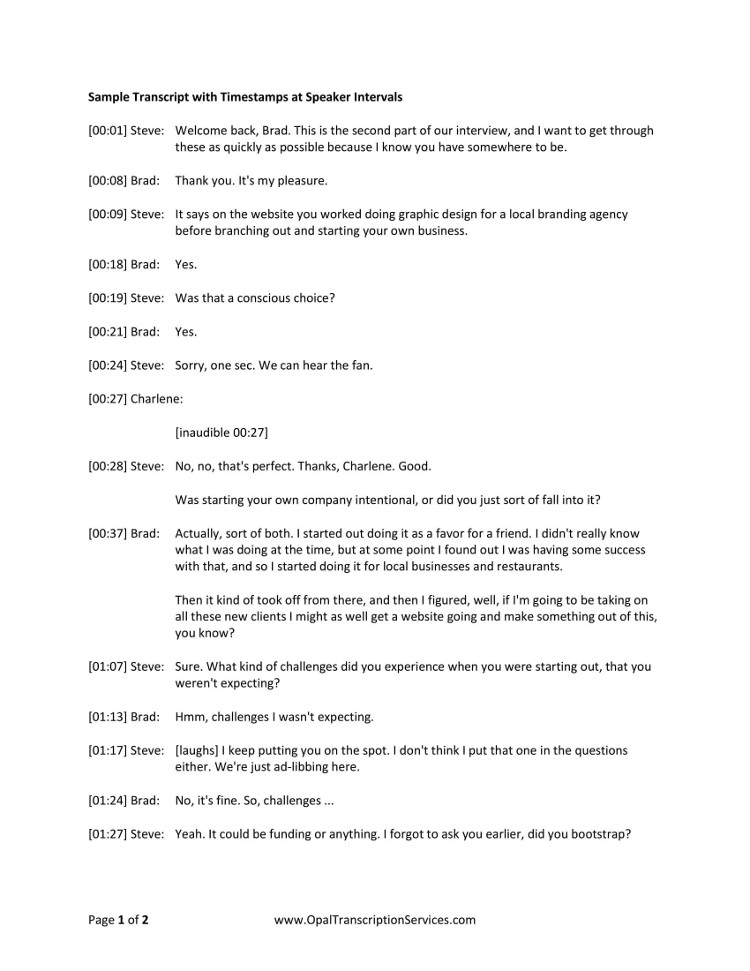
Download the PDF version here: Interview Transcript Example – Timestamps at Speaker Intervals (PDF)
Transcript format tips
There are several formatting elements common to most transcripts. These include speaker labels, timestamps, inaudible and crosstalk tags, and markup for external sounds. Let’s look at how to handle each of these:
Speaker labels. Speakers are typically identified by first name, full name, title, or role. They can also be identified by generic descriptors, like “Male” or “Female,” when other information isn’t available.
In the above examples, the speakers’ names have been offset from the rest of the transcript for better readability. To use this formatting in your own transcripts, download the .docx template at the top of this article.
Timestamps. Timestamps, e.g. [01:27] , can be placed at regular intervals such as every 15 or 30 seconds, or they may be placed at the beginning or end of each paragraph or speaker. Examples of each style are shown above.
Inaudible tags. When words or phrases are unclear, mark them out with a timecode; e.g., [inaudible 00:27] . You can also include guesses (phonetic or otherwise) as to what was said – for example, [wing yard 00:27] .
Crosstalk tags. When two or more speakers are talking at the same time and it’s impossible to hear what’s being said, use a crosstalk tag, e.g. [crosstalk 01:27] .
Sounds. Non-speech and background sounds are notated in brackets; for example, [laughing] or [door slams] . No timestamp is necessary.
Finally, a note on consistency and style: It’s best to follow a style guide to ensure consistency among elements like numerals, dates, titles of works, etc. We generally follow AP style . Other common style methods include APA , MLA , and The Chicago Manual of Style .
If you’re thinking of starting a career in transcription, check out my complete guide on how to become a transcriptionist . I also recently posted this list of 75+ transcription jobs for beginners and pros.
If you have any questions about using the example transcripts above, leave a comment and I’ll do my best to help!
Similar Posts

7 Best Video Prospecting Tools for Sales Pros in 2024
![qualitative research interview script Best Transcription Software for Audio and Video [2023]](https://www.mondayroadmap.com/wp-content/uploads/transcription-software-768x480.png)
Best Transcription Software for Audio and Video [2023]
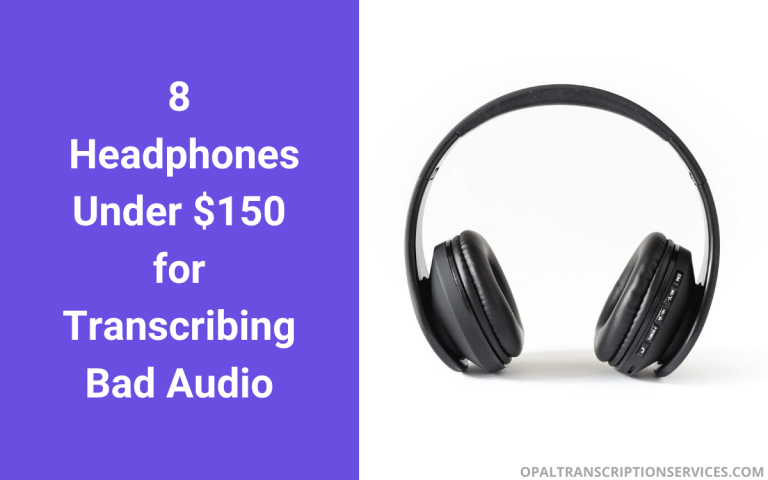
8 Best Transcription Headphones in 2024

6 Best Private Streaming Platforms for Securely Broadcasting Live Events
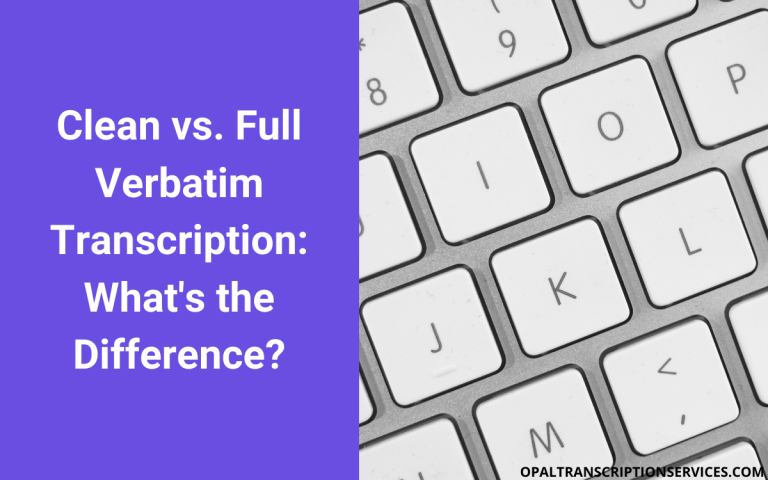
Verbatim Transcription vs. Non-verbatim Transcription Rules
![qualitative research interview script 6 Best AI Video Upscaling Software [Free and Paid]](https://www.mondayroadmap.com/wp-content/uploads/ai-video-upscaling-768x480.png)
6 Best AI Video Upscaling Software [Free and Paid]
23 comments.
thanks a lot for this. I appreciate th above lessons. at the moment lets keep the above into practice.
You’re very welcome! I’m glad you found it useful.
Very very helpful. For sure, God bless you.
Thank you. I’ve recently launched my own company in ghostwriting & editing, and typing & transcription services. These tips are GREAT reminders. God bless you.
Thank you, Mrs. Owens!
Handy for a beginner like me.
Thank you very much, really help me to do my assignment
I’m glad to hear that!
Hello, I don’t know how to thank you ,these instructions are very helpful and useful and real ,and how to contact you if I need any help.
I’m so happy you enjoyed the post! While I’m not always available to respond directly to questions, I always appreciate receiving suggestions about what kind of content you’d like to see me write about in the future. So if there’s a particular topic you have in mind, please feel free to reply and let me know. Thanks so much for commenting!
Your information is very valuable. My problem is, I need to find a resource that tells me how to set up the formatting in MSWord 2016. Setting the speaker tags and margins so it all lines up. If you have any link you could direct me to, or if you can explain how you do that, I would be forever grateful. Thanks, Lorri
I’ve been meaning to get a refresher on formatting myself and recently bookmarked this comprehensive tutorial on MS Word 2016: https://www.youtube.com/watch?v=TxLuuNprjXg
I haven’t watched it yet, but there’s a clickable table of contents in the video description and it has some sections on formatting and adjusting margins. I hope it helps!
how to name an interview transcript document?
If you’re doing the transcript for a client or professor, you should typically give the document the exact same name as its corresponding audio file; for example, “Interview with Sahar.mp3” would be titled “Interview with Sahar.docx”.
If you’re recording the audio yourself and there are a lot of files, it’s best practice to use some kind of file naming convention to keep everything organized. One easy way to do this is to use a date prefix; for example, 2019-05-30_Interview_with_Sahar.mp3.
I hope this helps!
Thank you so much for this guide. I am just about to embark on Transcription services as a full time activity and will be grateful for any mentoring and encouragement
You’re very welcome! Since you’re just getting started, I recommend visiting the following resources:
My complete guide on how to become a transcriptionist: https://www.mondayroadmap.com/how-to-become-a-transcriptionist/
My list of 75+ companies that hire work-from-home transcribers: https://www.mondayroadmap.com/online-transcription-jobs/
All the best in your new transcription career!
Thank you, this was very helpful.
Glad to hear it, Cony! Thanks for commenting.
This was really really helpful. Thank you so much.
Thank you for reading!
Hi, I’m just getting started transcribing hours of interviews. This article is a life saver. Really helpful, accessible, clear and the .pdfs are really useful allowing me to see what the finished transcription should look like. Thank you so very much.
You’re so welcome, Shaz! Thank you for reading!
Leave a Reply Cancel reply
Your email address will not be published. Required fields are marked *

IMAGES
VIDEO
COMMENTS
iral Hepatitis: Semi-structured interview. M / F. Provider / community member / both. Age. Region. 1. Qualitative interview introduction. Length: 45-60 minutes. Primary goal: To see things the way you see them… more like a conversation with a focus on your experience, your opinions and what you think or feel about the topics covered.
• Comprehend each step in the process of conducting and preparing qualitative interviews for analysis Qualitative Interviews Interviewing has a long-standing history within and outside of research situations. Interviews can be short and personal, such as when you visit medical offices trying to find a new doctor. Interviews also occur in ...
A good interview transcript will demonstrate a subtly controlled conversation by the skillful interviewer. In general, you want to see replies that are about one paragraph long, not short sentences and not running on for several pages. ... "Qualitative Interviews in Medical Research." BMJ: British Medical Journal 31(6999):251-253. A good ...
As such, the interviewee should seek to establish rapport with the interviewee. Choose a comfortable setting for the interview that is free from distractions. 3. Open the interview with easy questions that the interviewee can answer confidently, or even begin with friendly, off-topic conversation Explain in broad terms the goals of the research ...
health research: a qualitative study protocol 2 Appendix 2: Participant Information Sheet Experiences with Methods for Identifying and Displaying Research Gaps We invite you to take part in our research study. Before you decide whether to participate, you should understand why the research is being done and what it will involve.
research for both writing interview protocol that elicit useful data and for conducting the interview. This piece was originally developed as a classroom tool and can be used by professors teaching qualitative research in conjunction with academic readings about qualitative interviewing. Keywords: Qualitative Interviewing, Interviewing Tips, New
If you need 10 interviews, it is a good idea to plan for 15. Likely, a few will cancel, delay, or not produce useful data. 5. Not keeping your golden thread front of mind. We touched on this a little earlier, but it is a key point that should be central to your entire research process.
Introduction. In medical education research, the qualitative research interview is a viable and highly utilized data-collection tool (DiCicco-Bloom and Crabtree Citation 2006; Jamshed Citation 2014).There are a range of interview formats, conducted with both individuals and groups, where semi-structured interviews are becoming increasingly prevalent in medical education research.
Steps for undertaking a qualitative interview. Arrival - rapport building. Introducing the topic - informed consent. Beginning the interview - non-sensitive background information. During the interview - guided exploration of the topic. Ending the interview - suggest interview is winding down, give opportunity for interviewee to ...
It is the most widely used method in qualitative research. It is flexible, inexpensive, and does not inter-fere with the researcher's life the way that ethnography does. This chapter looks at qualitative interviewing and how it compares to other types of collect-ing evidence in research, particularly structured interviewing and ethnography.
There are several types of interviews, often differentiated by their level of structure. Structured interviews have predetermined questions asked in a predetermined order. Unstructured interviews are more free-flowing. Semi-structured interviews fall in between. Interviews are commonly used in market research, social science, and ethnographic ...
Post-interview. ☐ Review and clarify interview notes. ☐ Record reflections in field notes (refer to participant ID only) ☐ Verify integrity of audio recording. ☐ Store interview audio on shared drive; destroy all other copies after copy has been verified intact. ☐ Store all paper in locked cabinet in Scott 205C.
Step 1 - Initial coding. The first step of the coding process is to identify the essence of the text and code it accordingly. While there are various qualitative analysis software packages available, you can just as easily code textual data using Microsoft Word's "comments" feature.
Three sample interview transcripts. The following three transcripts have been provided to help you test your coding skills. Please note these will open in a new window. Interview Transcript: Digestive Disorders - Brenda. Interview Transcript - A Teacher's Observations of Child Oppression. Interview Transcript: Digestive Disorders - Sam.
Qualitative and quantitative interviews are different research approaches, each with a unique strategy for collecting and interpreting data. Quantitative interviews seek to measure human behaviour and experiences in a form that can be statistically examined, whereas qualitative interviews concentrate on investigating and comprehending the depth ...
This screencast will introduce you to qualitative research methods. **By the end of this screencast you will: Know a bit about the history of qualitative research in academia. Be familiar with the meaning of the term "naturalistic inquiry". Determine major differences between qualitative and quantitative approaches to research.
The 6 Steps of Qualitative Interview Data Analysis. Among qualitative interview data analysis methods, thematic content analysis is perhaps the most common and effective method. It can also be one of the most trustworthy, increasing the traceability and verification of an analysis when done correctly. The following are the six main steps of a ...
Translation. Recording. Summarizer. Scheduler. Our ultimate guide to transcribe interviews for qualitative research. 1. Decide the important interview information. 2. Confirm what kind of transcript you need. 3. Have your tools ready.
Qualitative interviews - ranging from unstructured to open-ended and to provocative - are methodologically well-established tools of social-scientific data gathering (see i.e. Kvale and Brinkmann, 2009; Roulston, 2010). They are very common in social sciences when it comes to studying the perspectives, experiences, explanations and ...
Download this transcription format template for Microsoft Word for use with interviews and qualitative research projects: Interview Transcription Template - Word (.docx) Clean verbatim vs. true verbatim transcript examples. There are two main styles of transcription used in interviews and qualitative research:
A qualitative study was conducted by conducting semi-structured interviews with CMNs (n = 31) from the province of Seville (Spain) and performing a narrative discourse analysis. ... The study follows the Standards for Reporting Qualitative Research (SRQR). ... the interviews were conducted following a previously designed script where questions ...